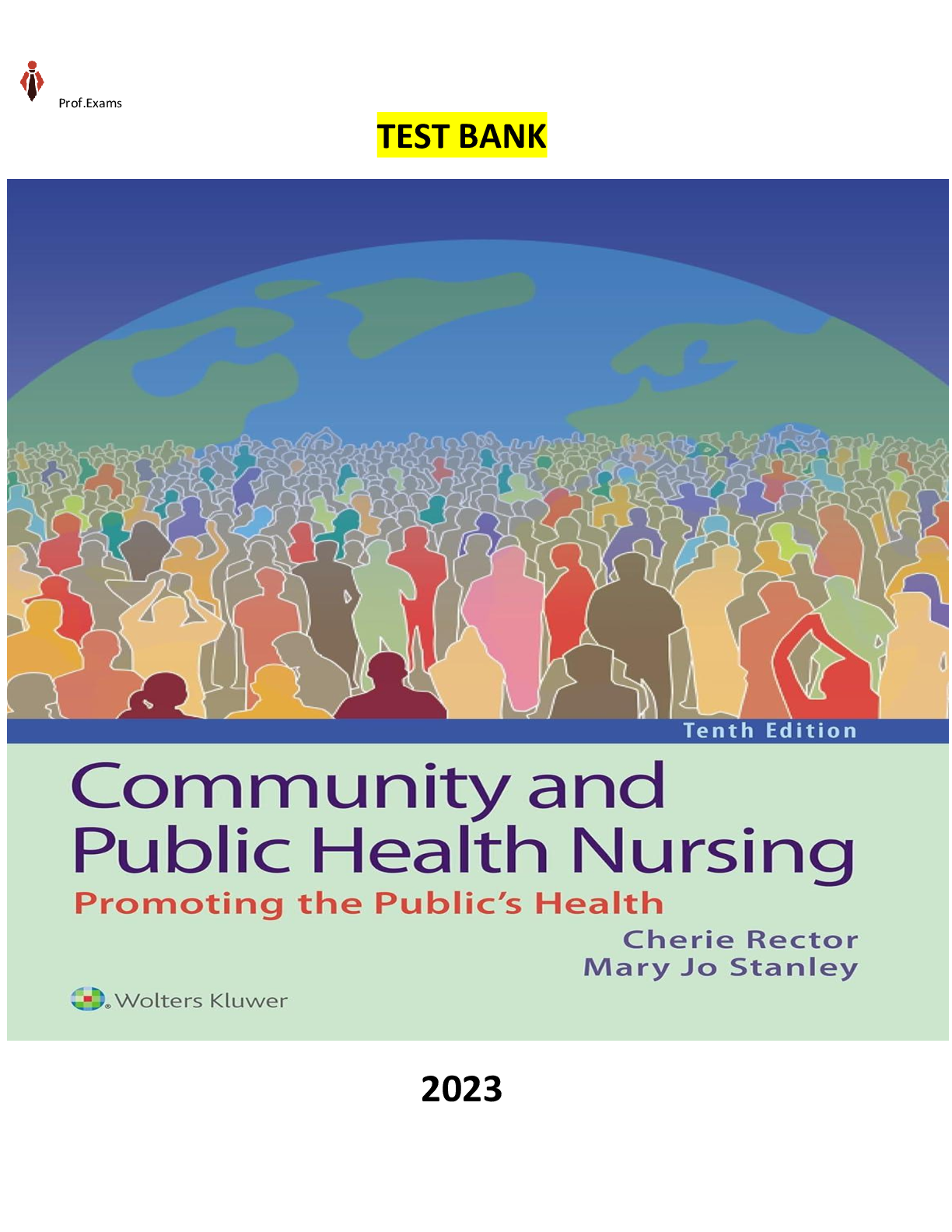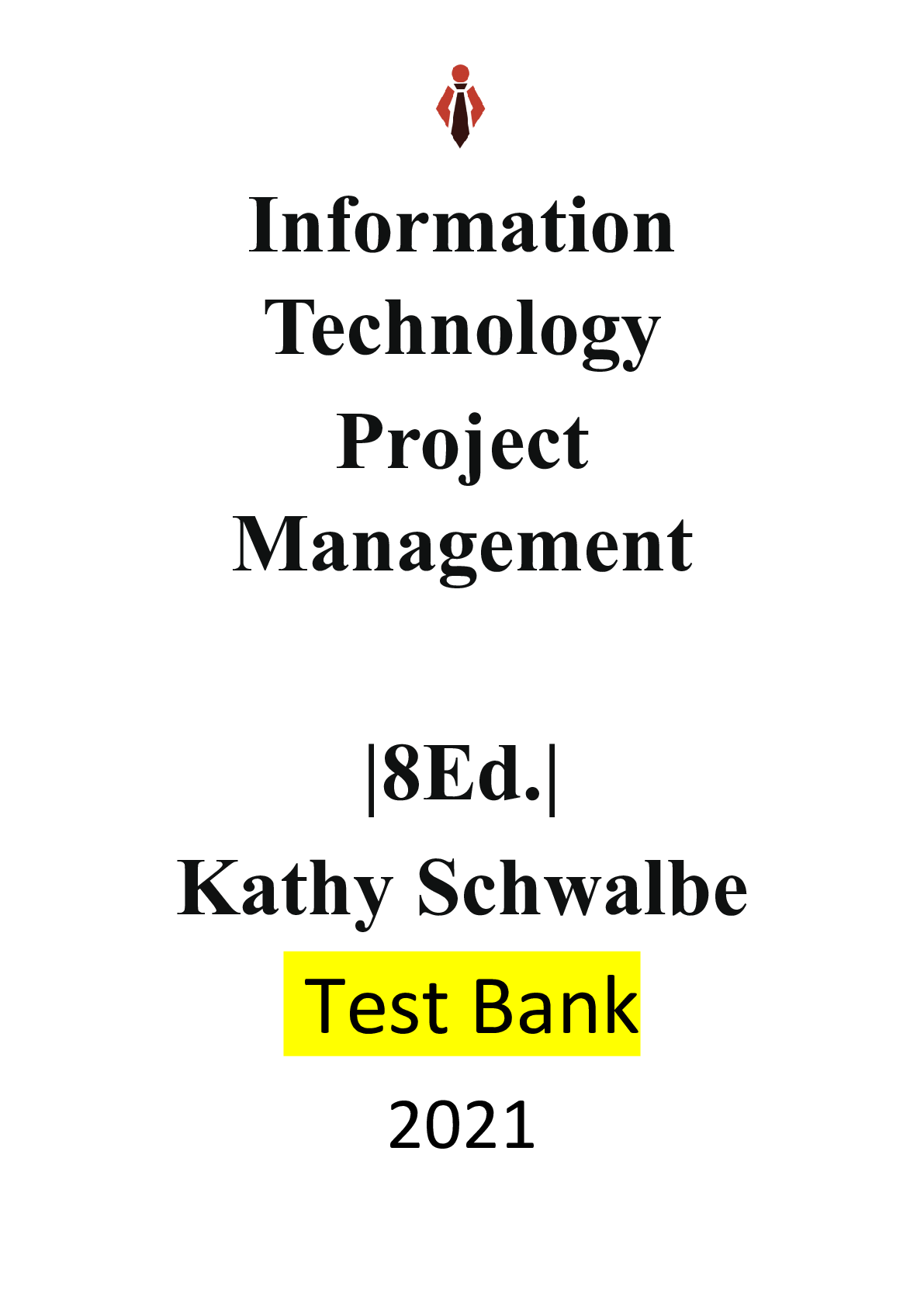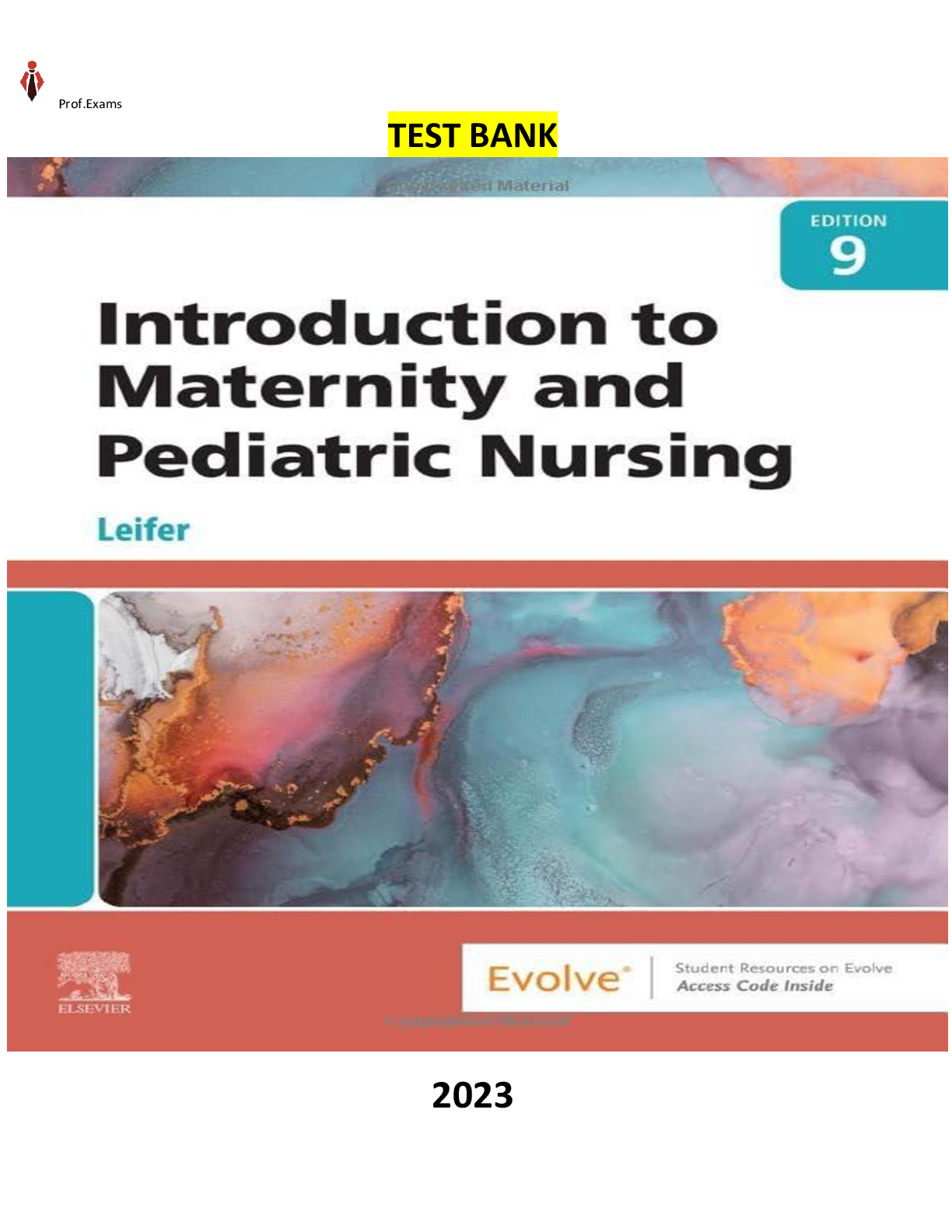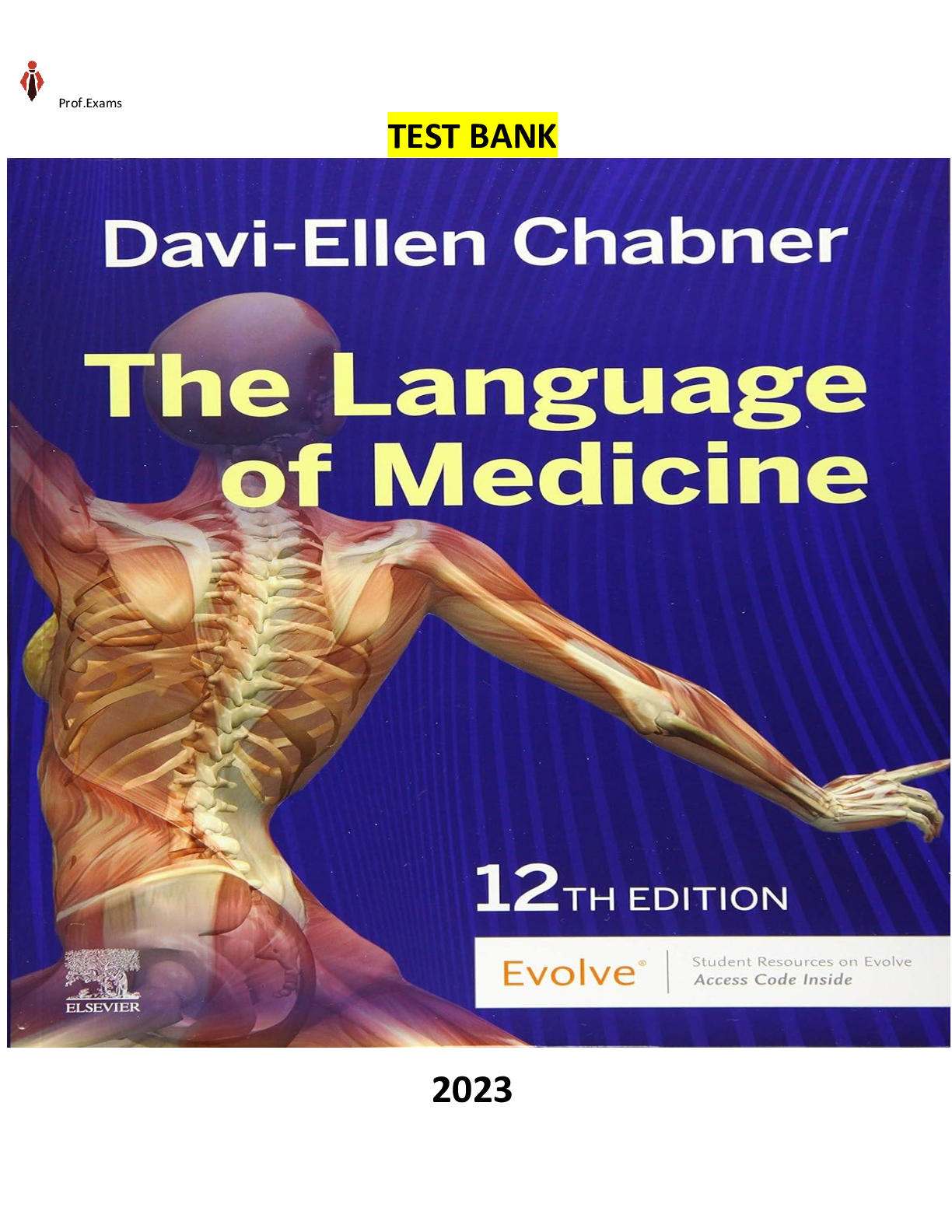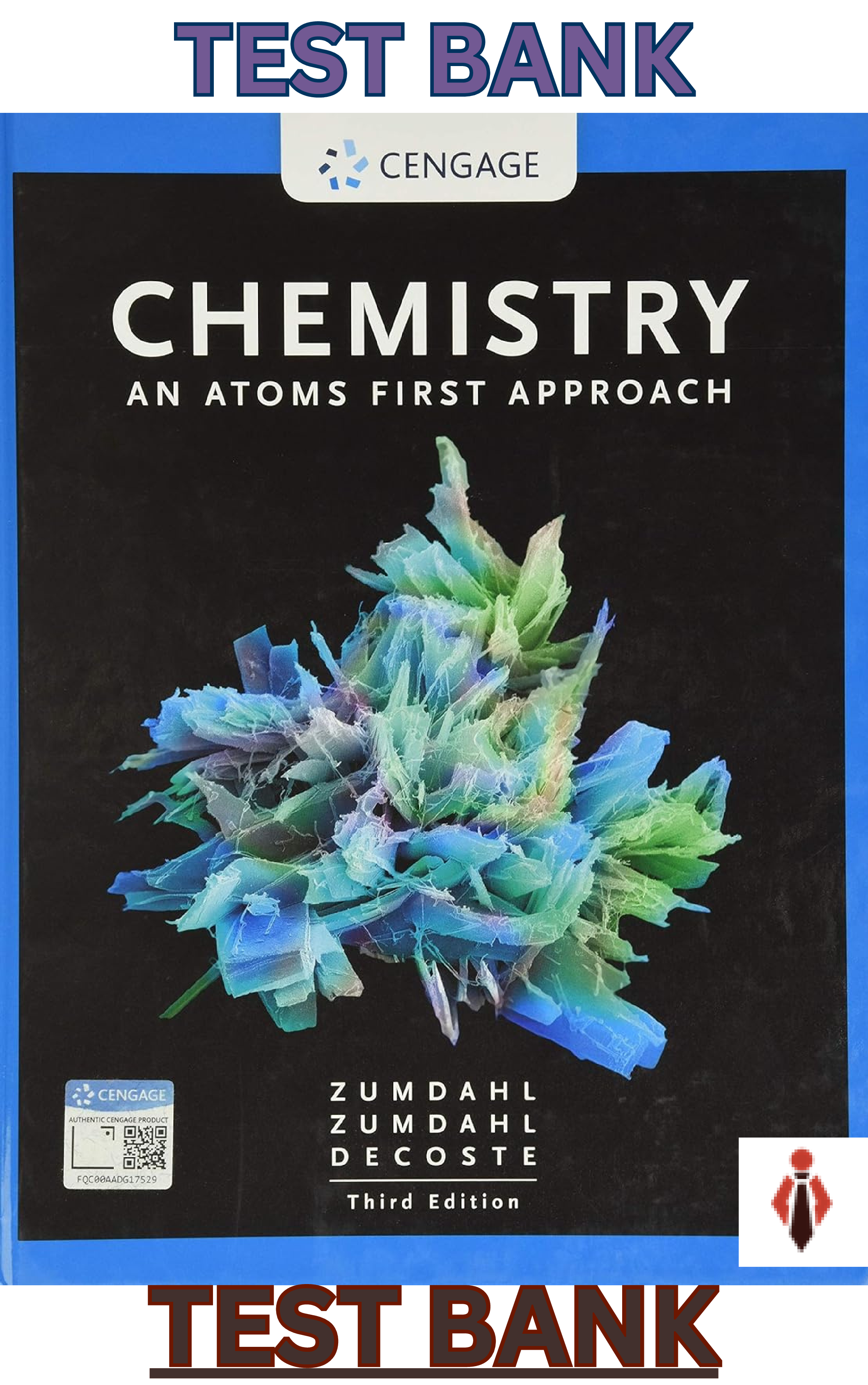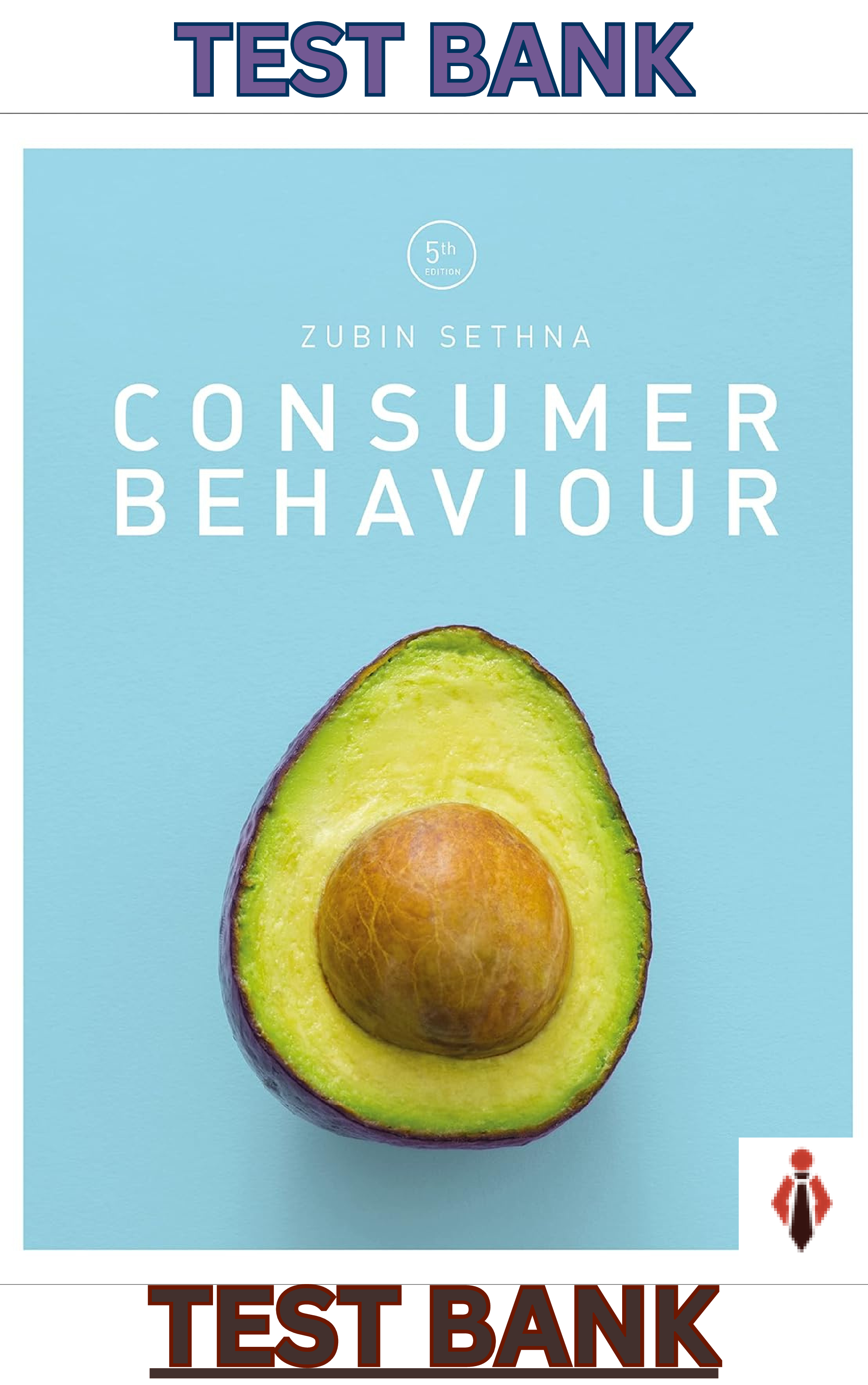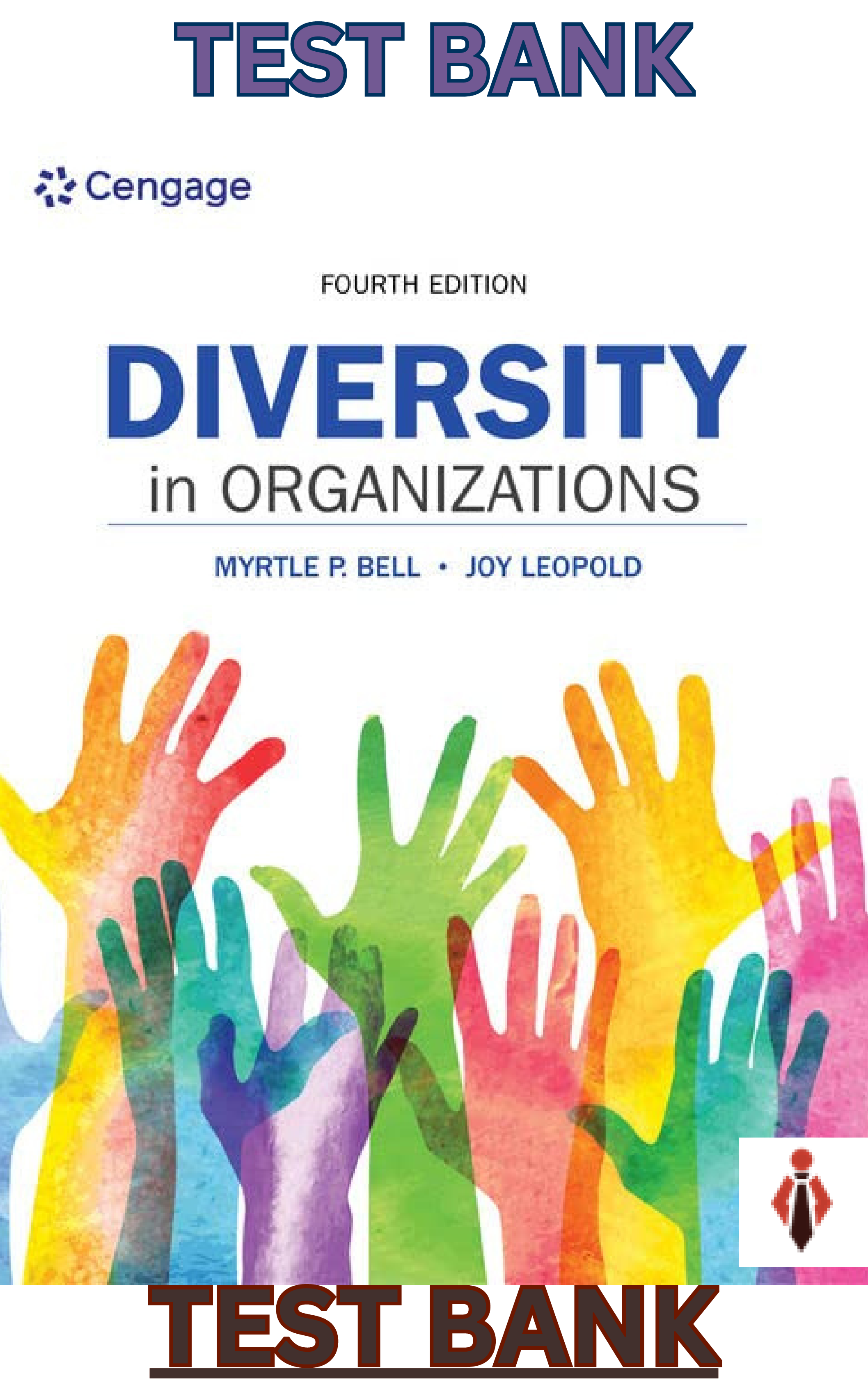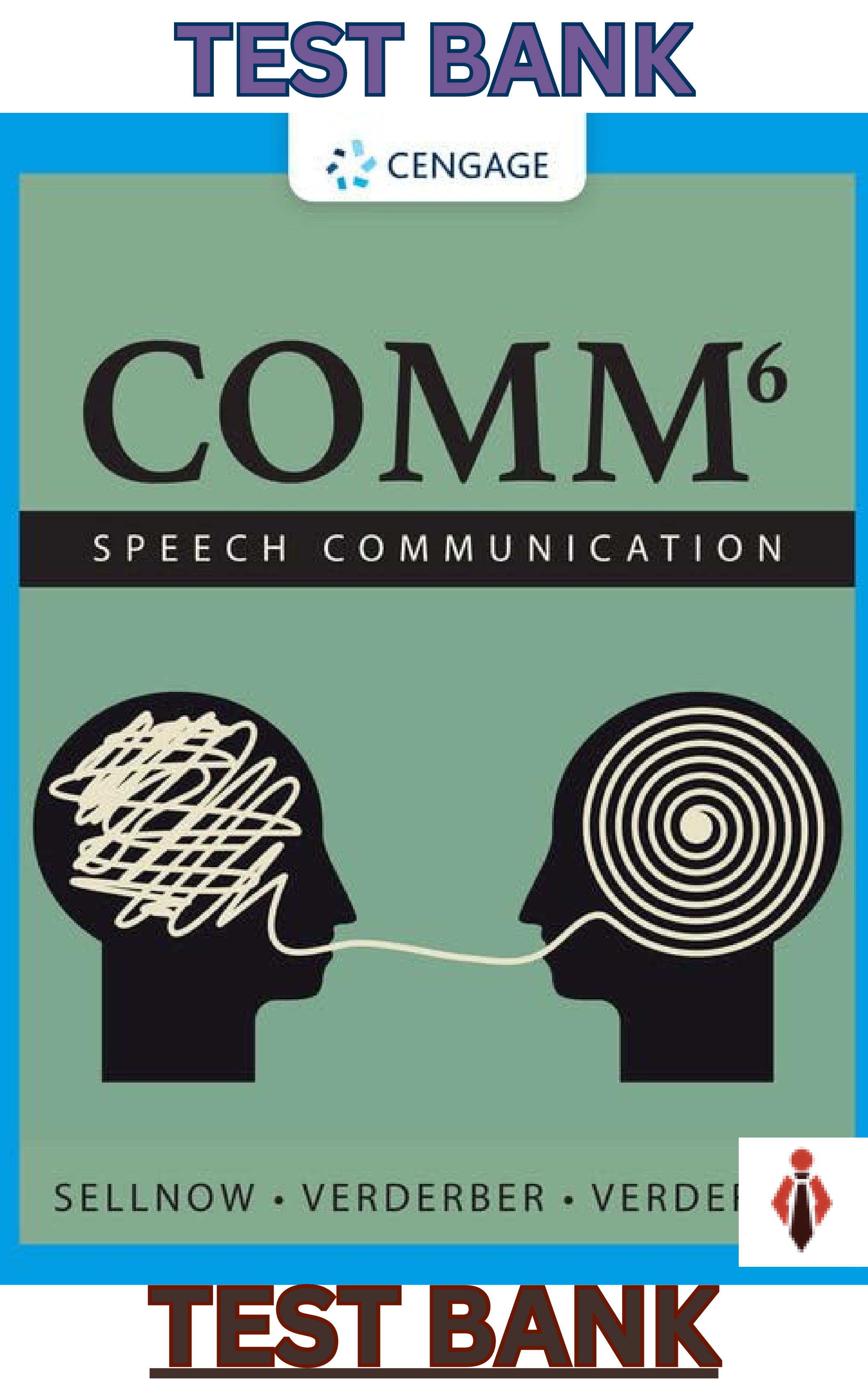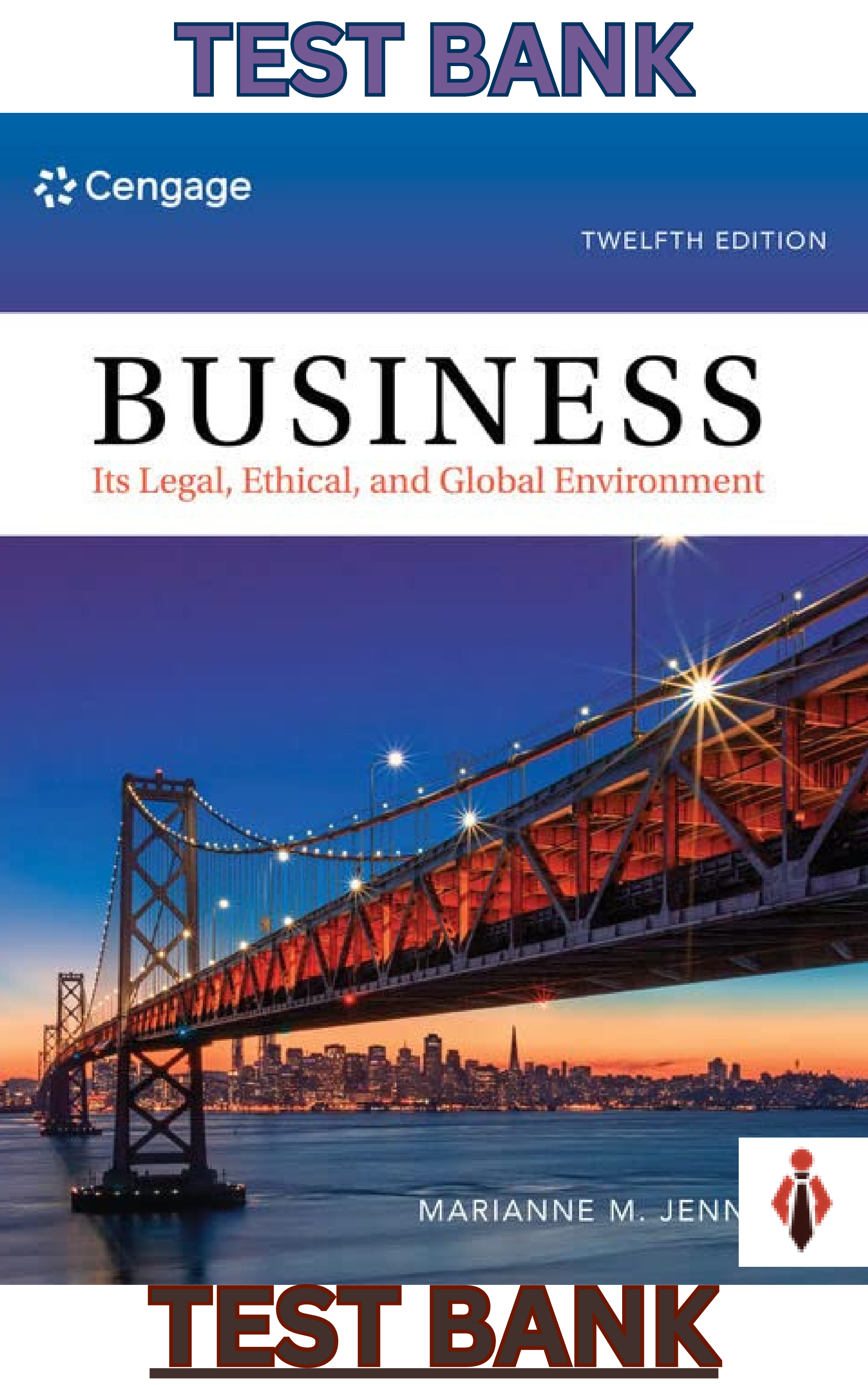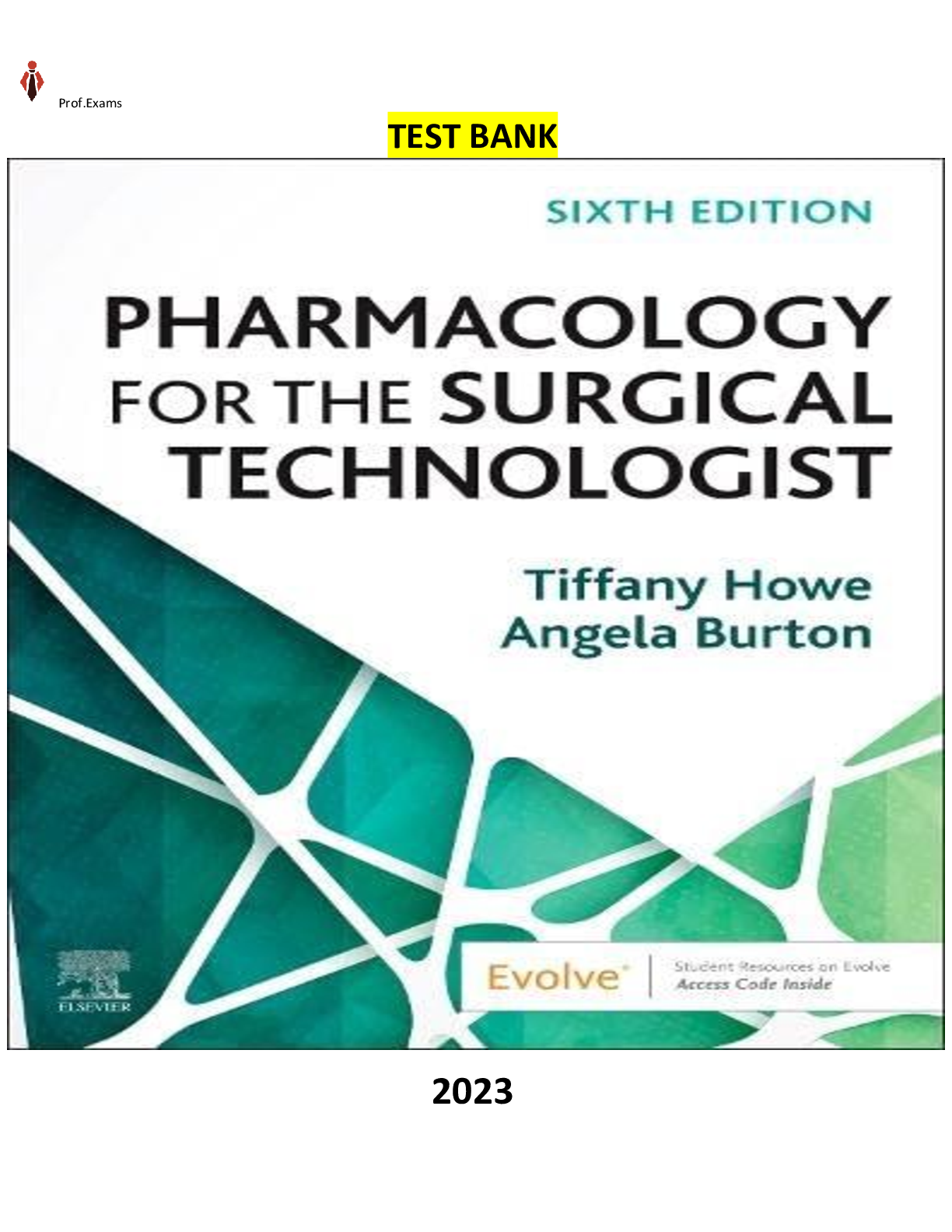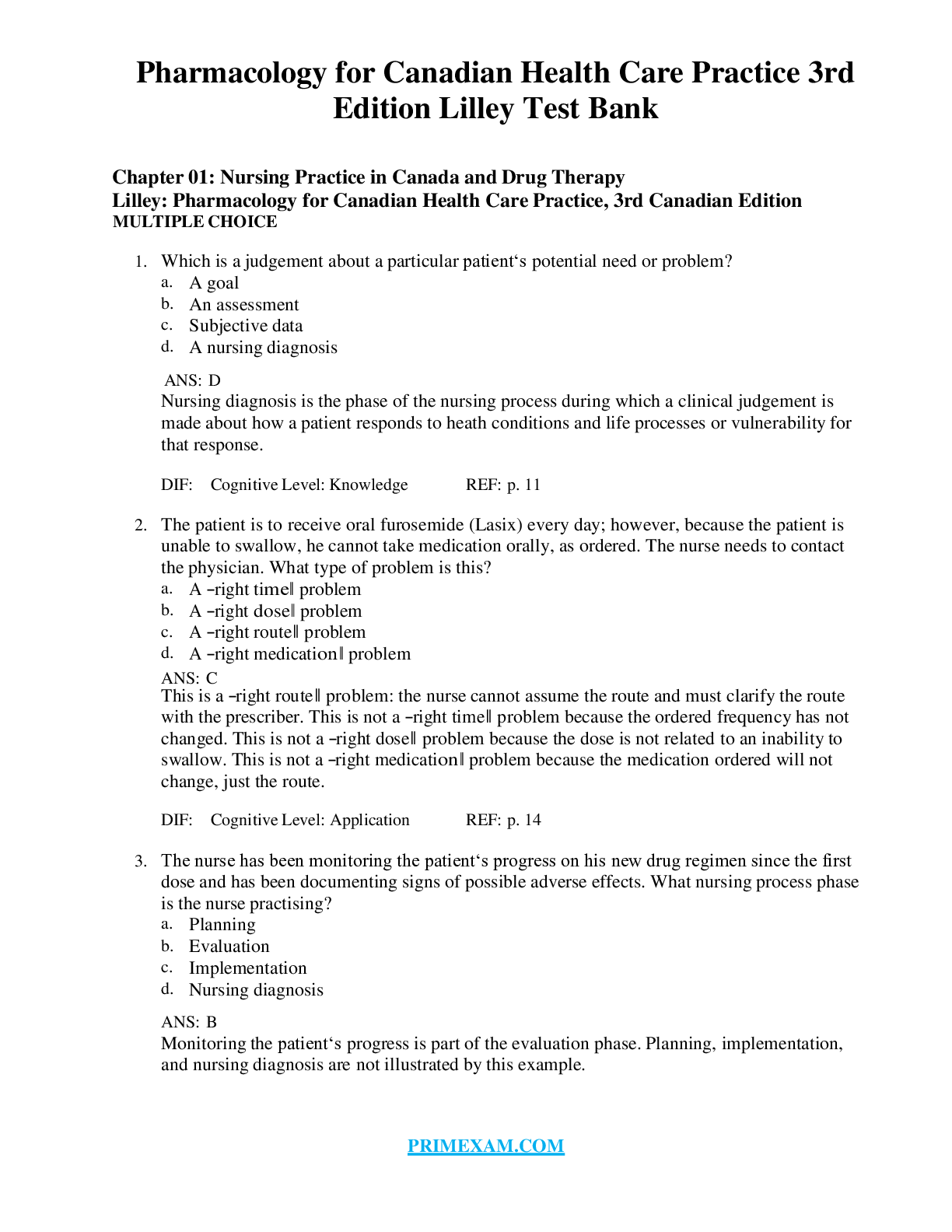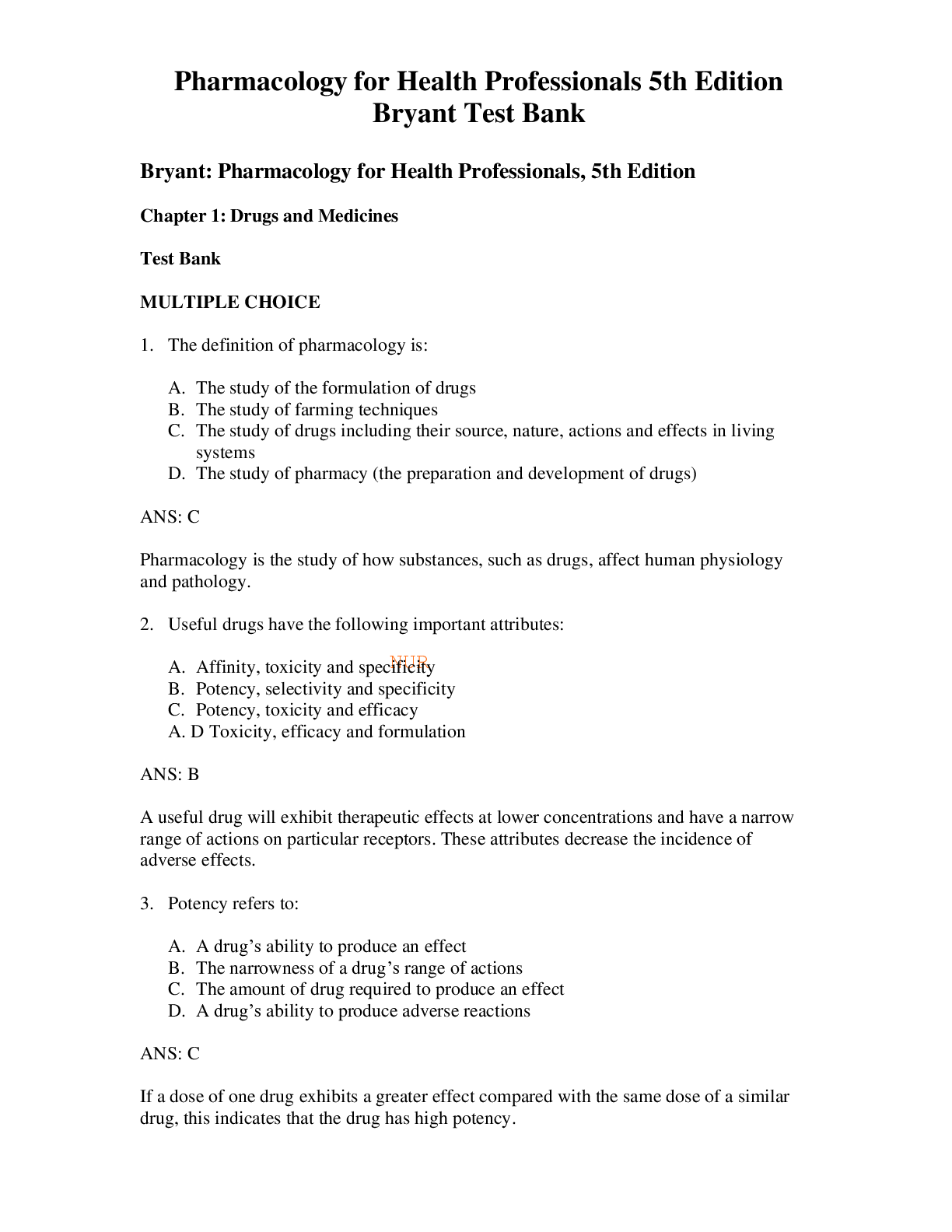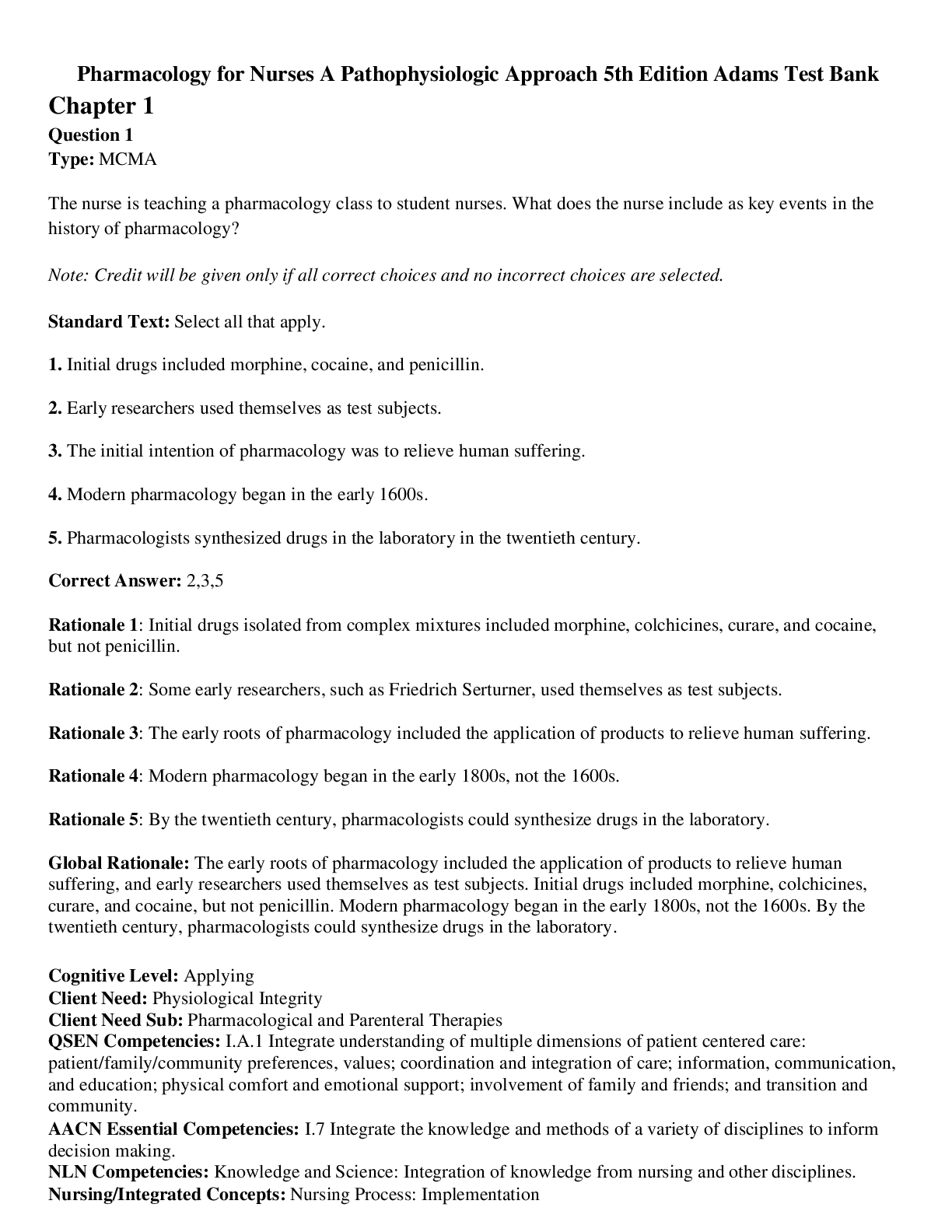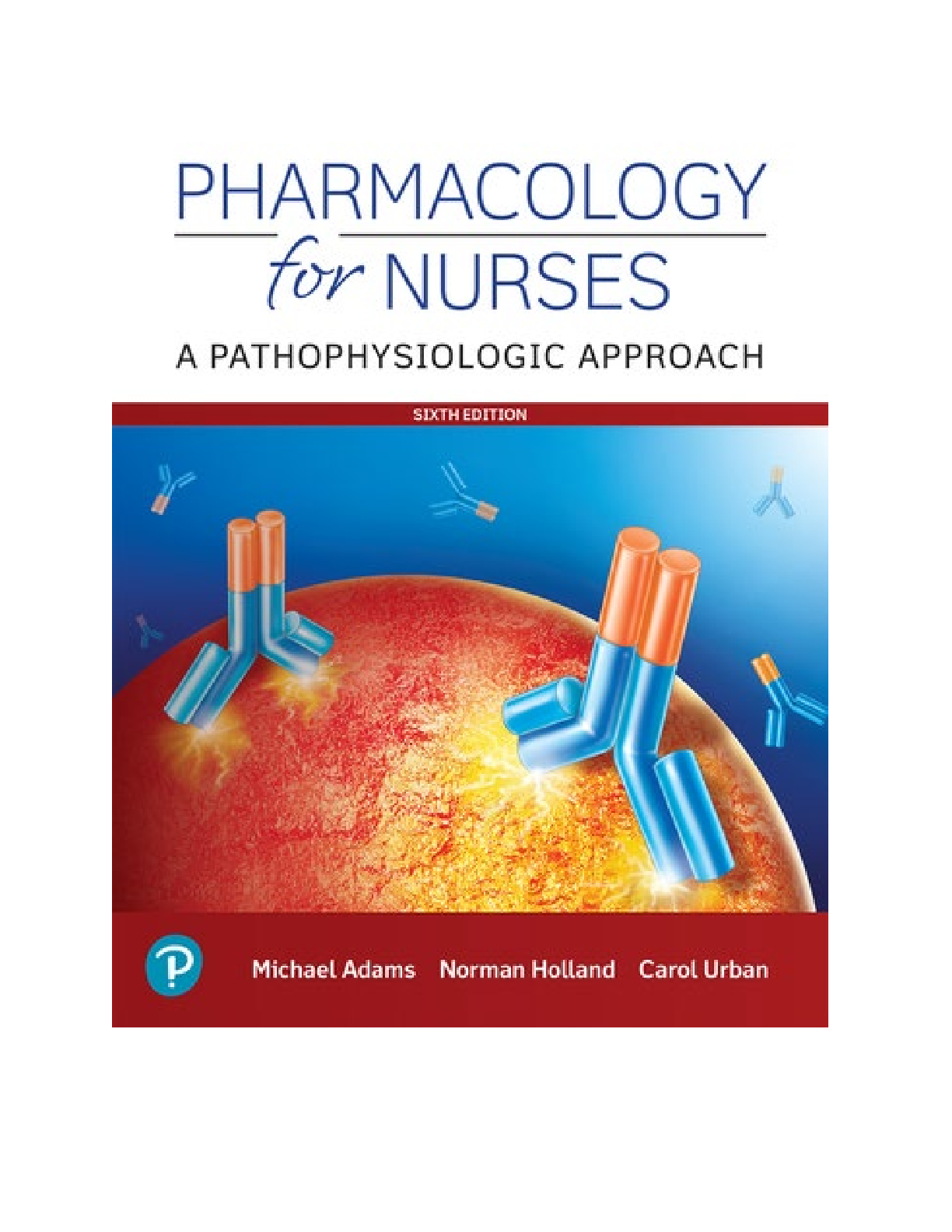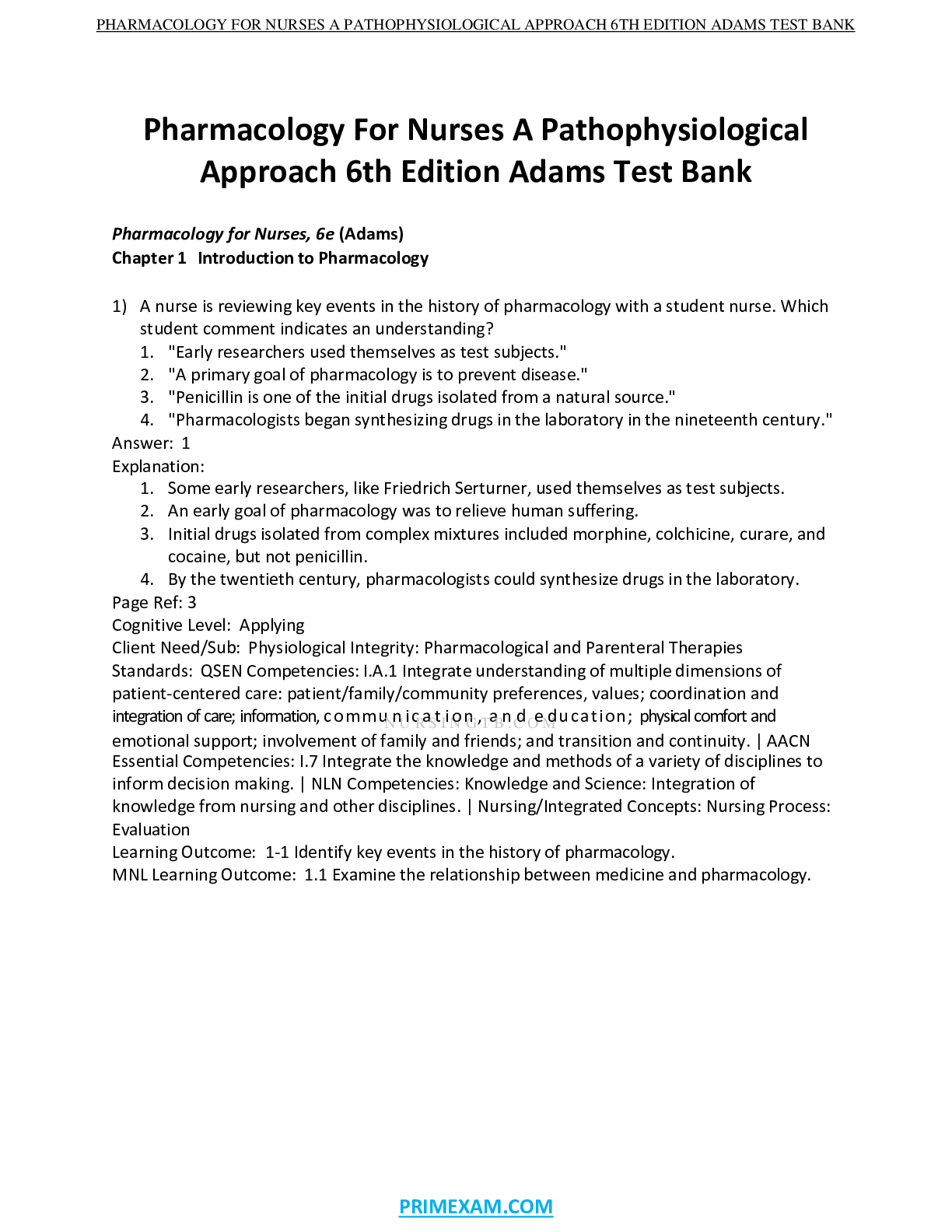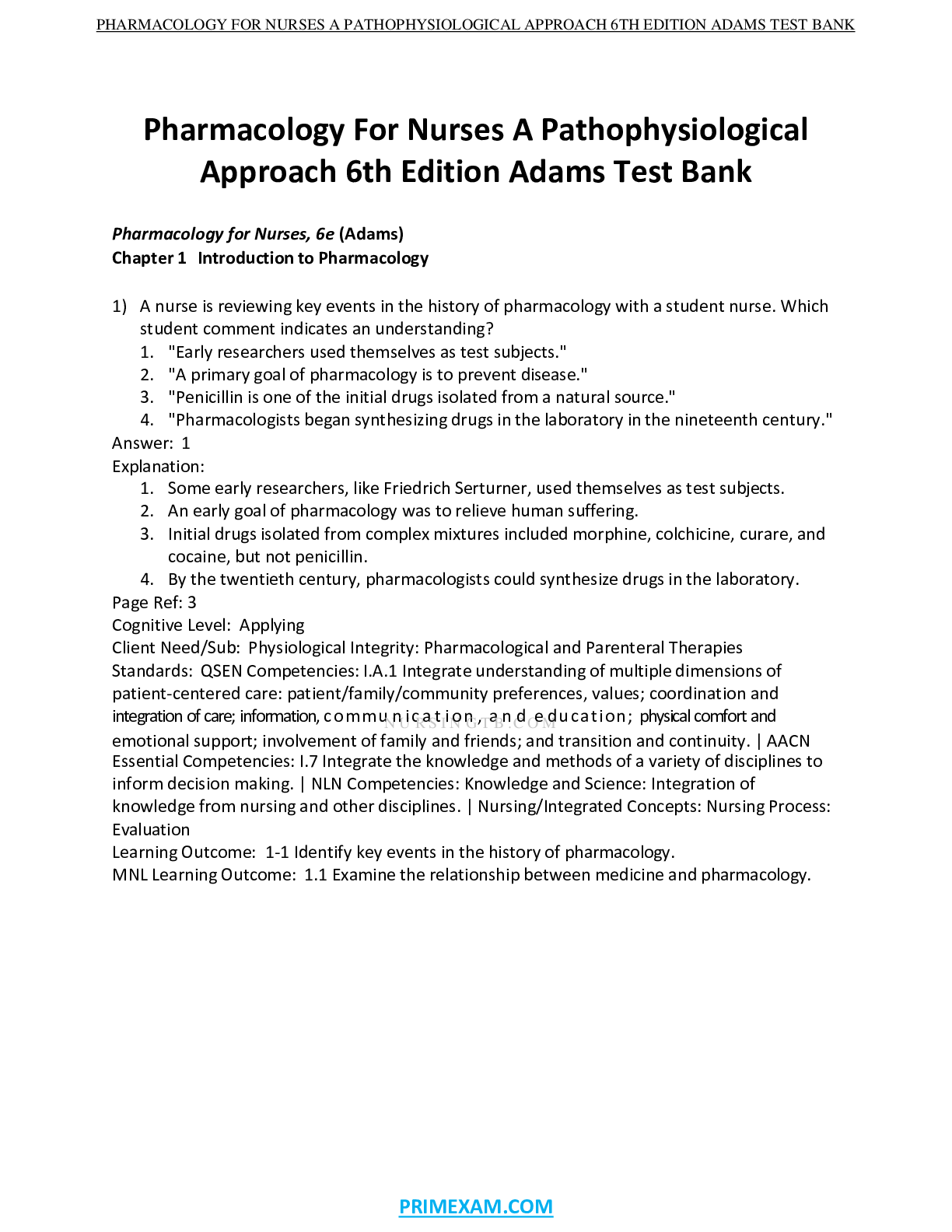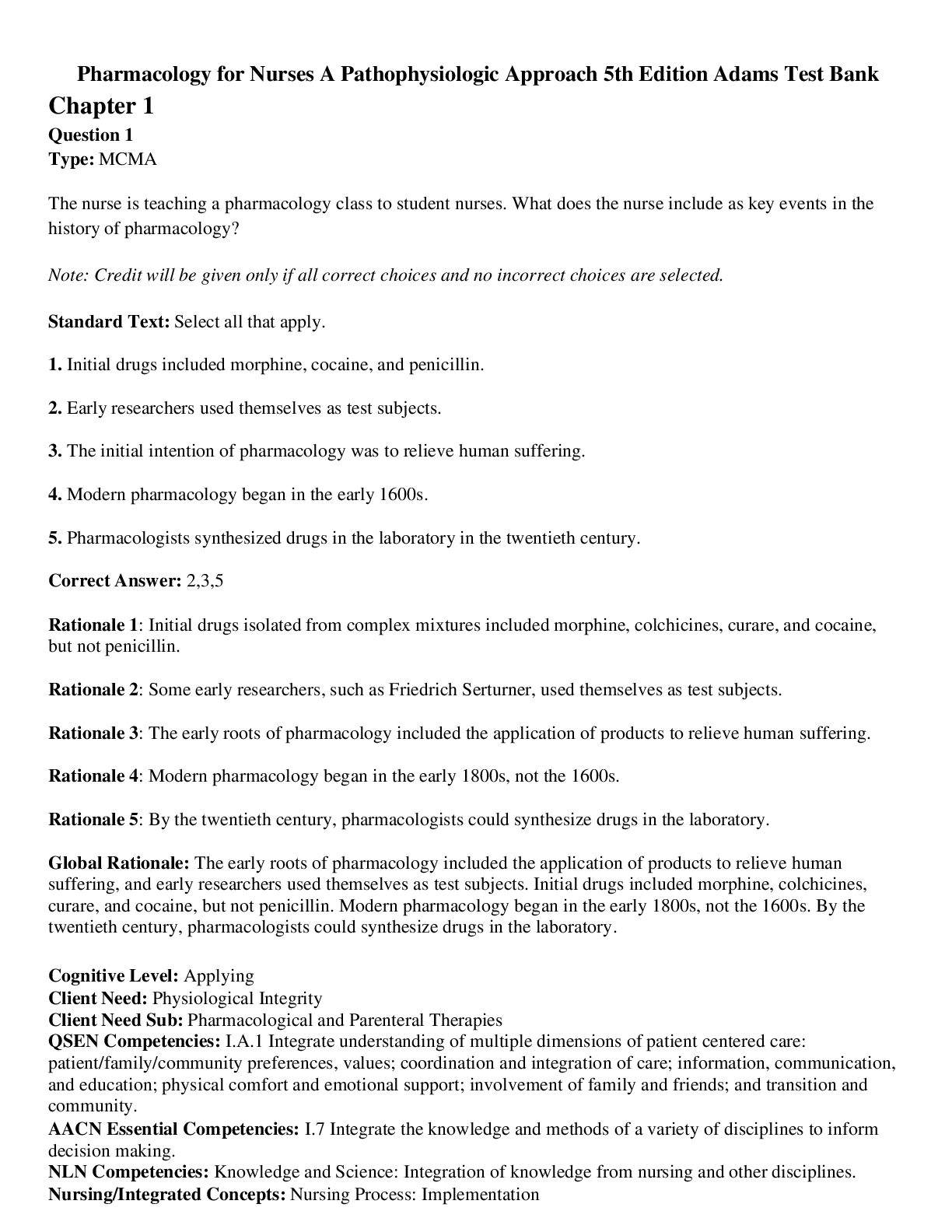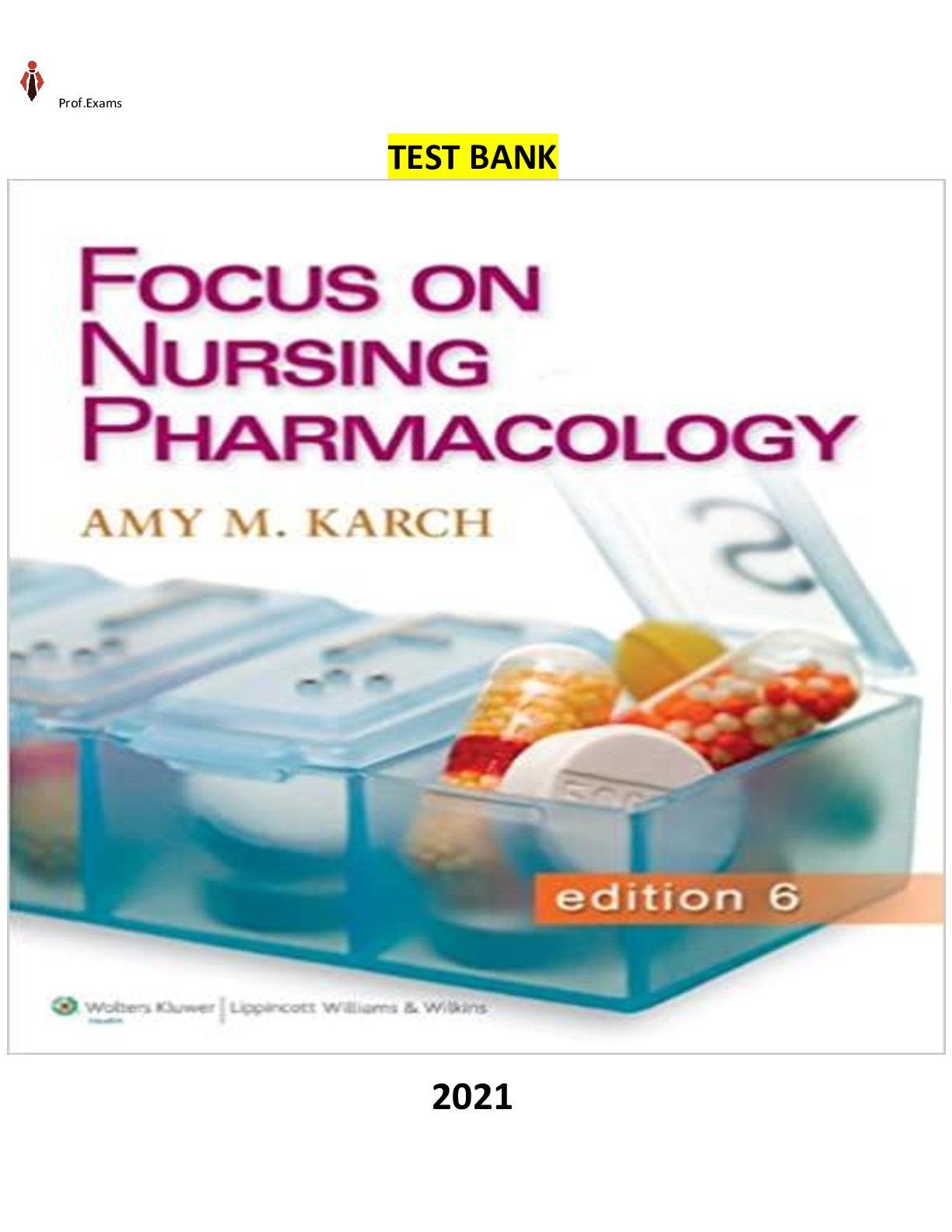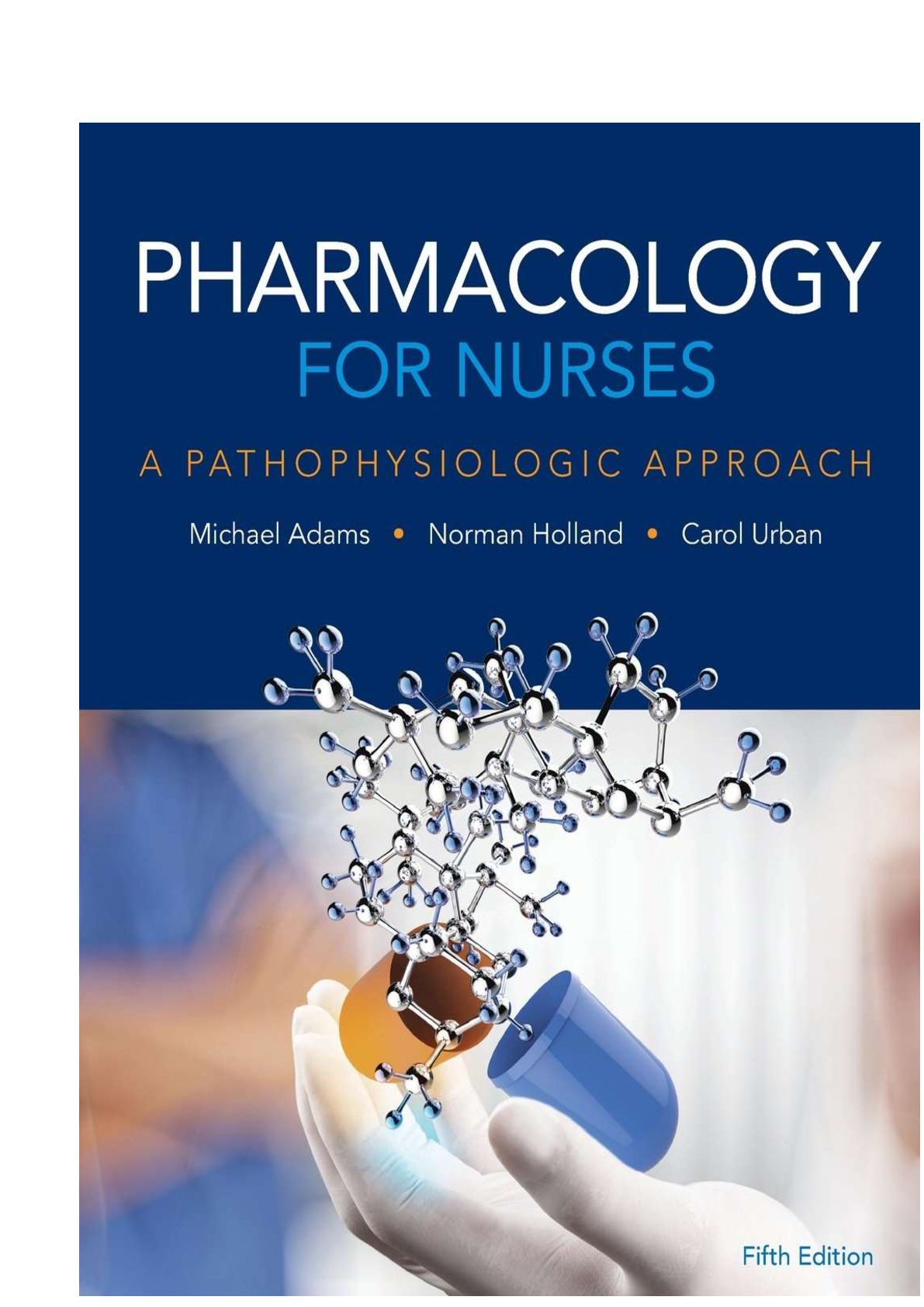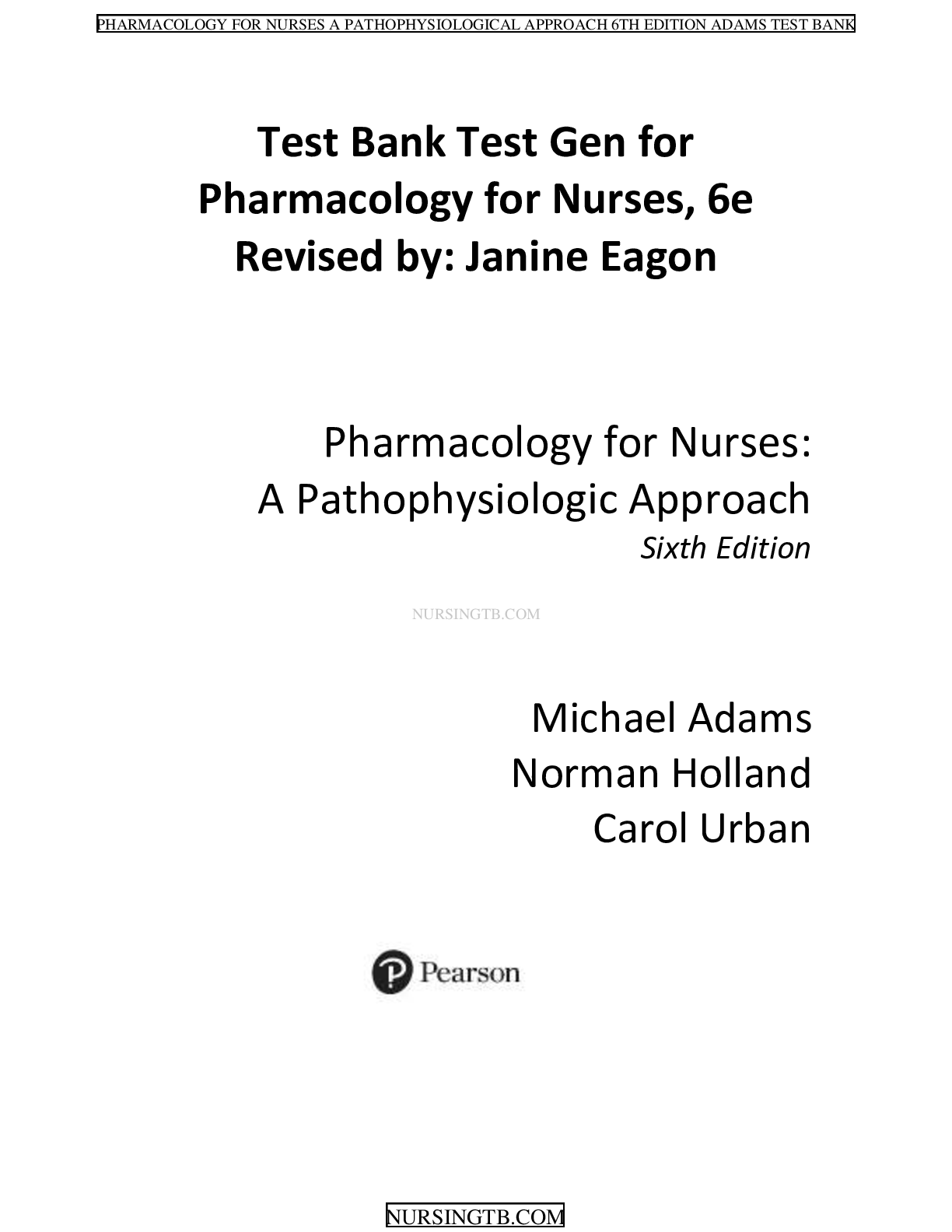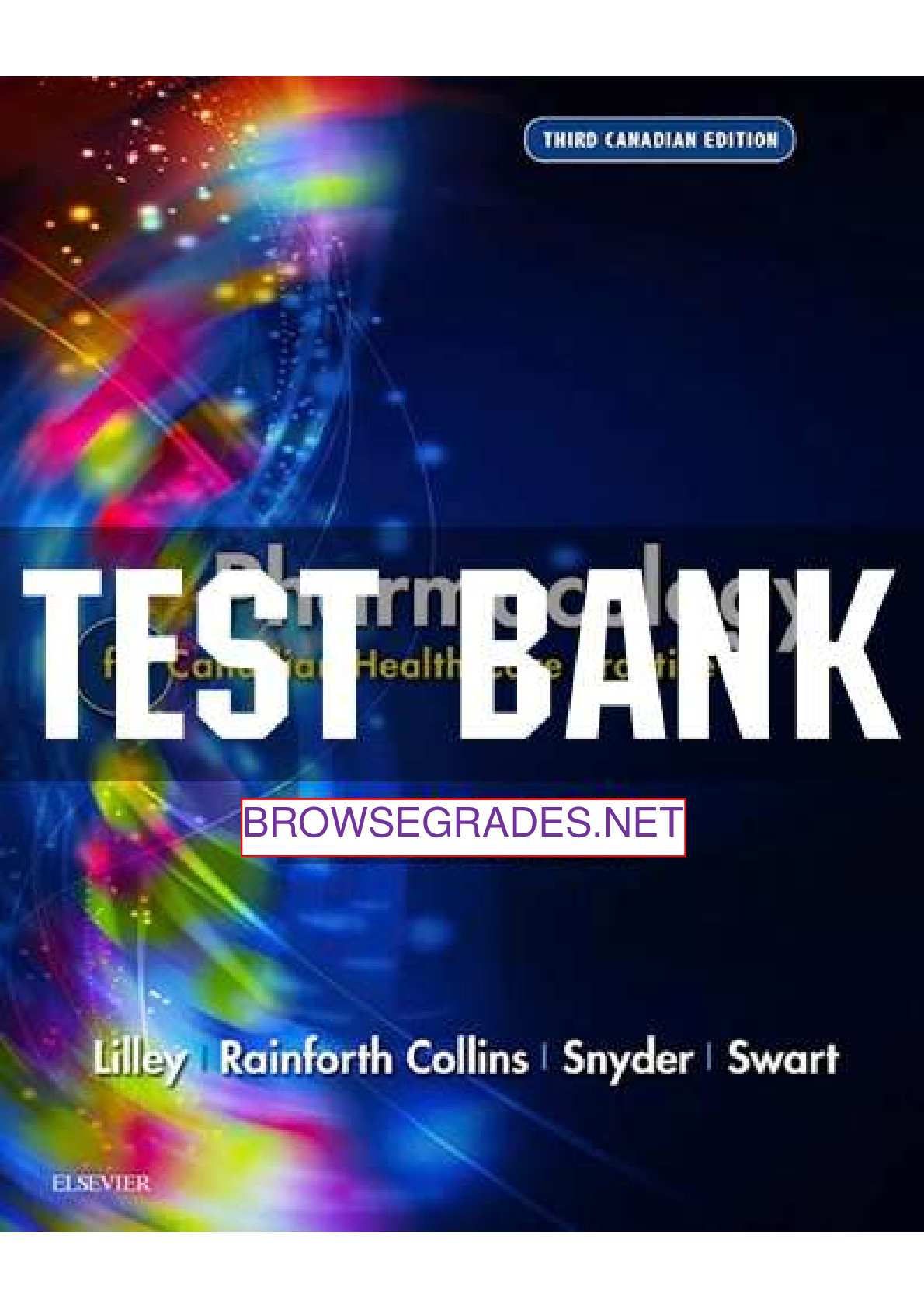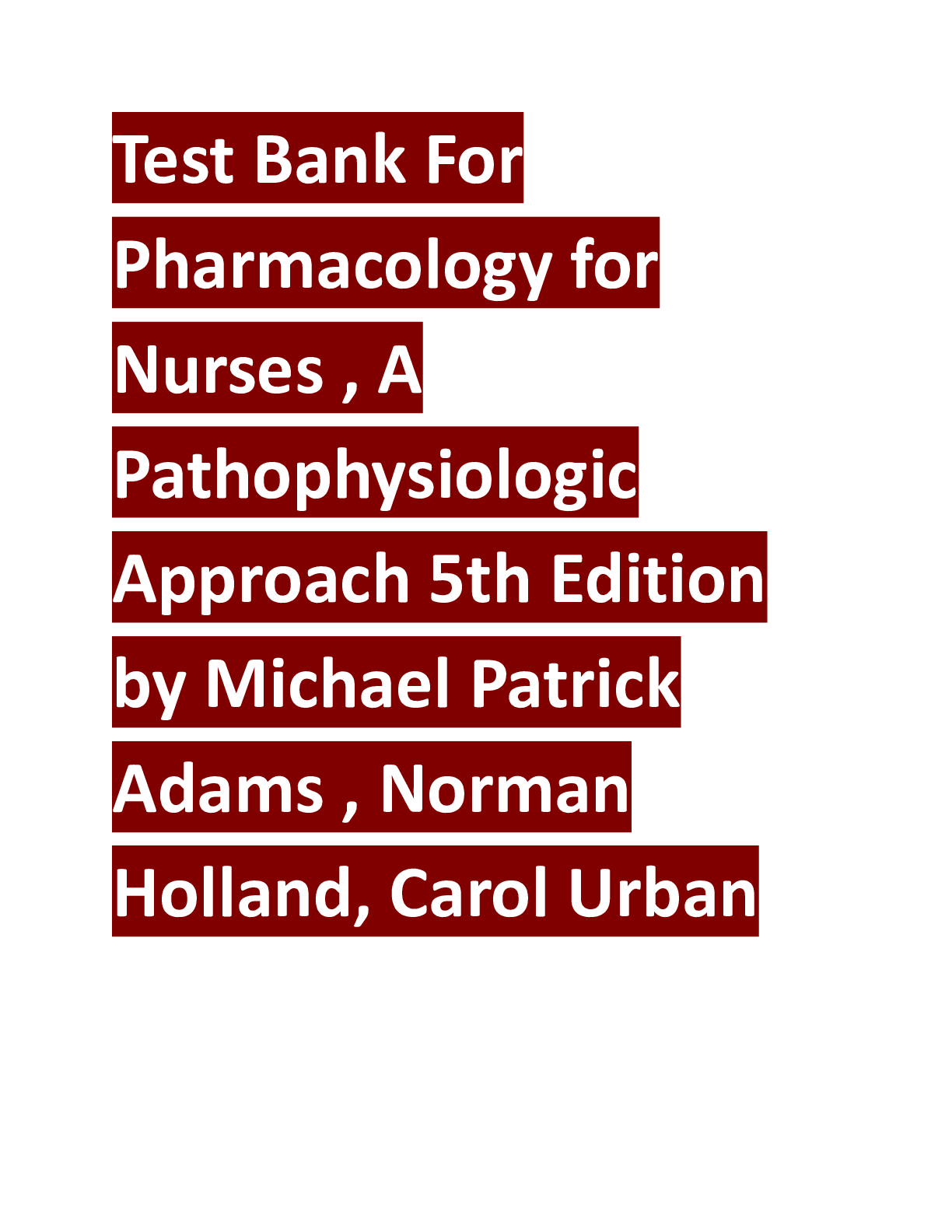Pharmacology > TEST BANK > TEST BANK for Pharmacology for Nurses A Pathophysiologic Approach 6Ed M. Adams,N. Holland,C. Urban-A (All)
TEST BANK for Pharmacology for Nurses A Pathophysiologic Approach 6Ed M. Adams,N. Holland,C. Urban-ALL 50 Chapters included Latest for 2022
Document Content and Description Below
TEST BANK for Pharmacology for Nurses A Pathophysiologic Approach 6Ed Michael Adams,Norman Holland,Carol UrbanUnit 1 Core Concepts in Pharmacology Chapter 1 Introduction to Pharmacology Learning Out... comes Key Terms 1.1 History of Pharmacology 1.2 Pharmacology: The Study of Medicines 1.3 Pharmacology and Therapeutics 1.4 Classification of Therapeutic Agents as Drugs, Biologics, Biosimilars, and Complementary and Alternative Medicine Therapies 1.5 Therapeutic and Pharmacologic Classification of Drugs 1.6 Chemical, Generic, and Trade Names for Drugs 1.7 Prescription and Over-the-Counter Drugs 1.8 Differences Between Trade-Name Drugs and Their Generic Equivalents 1.9 Decisions Relative to Proper Drug Choices Chapter Review Key Concepts Critical Thinking Questions Selected Bibliography Chapter 2 Drug Approval and Regulation Learning Outcomes Key Terms 2.1 Drug Regulations and Standards 2.2 The Role of the Food and Drug Administration 2.3 Phases of Approval for Therapeutic and Biologic Drugs 2.4 Changes to the Drug Approval Process 2.5 Prescriptive Authority for Nurses 2.6 Controlled Substances, Drug Schedules, and Teratogenic Risks Chapter Review Key Concepts Critical Thinking Questions References Selected Bibliography Chapter 3 Principles of Drug Administration Learning Outcomes Key Terms Responsibilities of the Nurse 3.1 Medication Knowledge and Understanding 3.2 The Rights of Drug Administration 3.3 Patient Adherence and Successful Pharmacotherapy 3.4 Drug Orders and Time Schedules 3.5 Systems of Measurement Routes of Drug Administration 3.6 Enteral Drug Administration Tablets and Capsules Sublingual and Buccal Drug Administration Rapid-Dissolving Tablets and Films Nasogastric and Gastrostomy Drug Administration 3.7 Topical Drug Administration Transdermal Delivery System Ophthalmic Administration 5 SturdyDrone Otic Administration Nasal Administration Vaginal Administration Rectal Administration 3.8 Parenteral Drug Administration Intradermal and Subcutaneous Administration Intramuscular Administration Intravenous Administration Chapter Review Key Concepts Review Questions Critical Thinking Questions References Selected Bibliography Chapter 4 Pharmacokinetics Learning Outcomes Key Terms 4.1 Pharmacokinetics: How the Body Handles Medications 4.2 The Passage of Drugs Through Plasma Membranes 4.3 Absorption of Medications 4.4 Distribution of Medications 4.5 Metabolism of Medications 4.6 Excretion of Medications 4.7 Drug Plasma Concentration and Therapeutic Response 4.8 Onset, Peak Levels, and Duration of Drug Action 4.9 Loading Doses and Maintenance Doses Chapter Review Key Concepts Review Questions Critical Thinking Questions Selected Bibliography Chapter 5 Pharmacodynamics Learning Outcomes Key Terms 5.1 Pharmacodynamics and Interpatient Variability 5.2 Therapeutic Index and Drug Safety 5.3 The Graded Dose—Response Relationship and Therapeutic Response 5.4 Potency and Efficacy 5.5 Cellular Receptors and Drug Action 5.6 Types of Drug—Receptor Interactions 5.7 Pharmacology of the Future: Customizing Drug Therapy Chapter Review Key Concepts Review Questions Critical Thinking Questions References Selected Bibliography Unit 2 Pharmacology and the Nurse–Patient Relationship Chapter 6 The Nursing Process in Pharmacology Learning Outcomes 6 SturdyDrone Key Terms 6.1 Overview of the Nursing Process 6.2 Assessment of the Patient 6.3 Nursing Diagnoses 6.4 Planning: Establishing Goals and Outcomes 6.5 Implementing Specific Nursing Actions Patient Education 6.6 Evaluating the Effects of Medications Chapter Review Key Concepts Review Questions Critical Thinking Questions References Chapter 7 Medication Errors and Risk Reduction Learning Outcomes Key Terms 7.1 Defining Medication Errors 7.2 Factors Contributing to Medication Errors 7.3 The Impact of Medication Errors 7.4 Reporting and Documenting Medication Errors Documenting in the Patient’s Medical Record Reporting the Error Sentinel and Patient Safety Events 7.5 Strategies for Reducing Medication Errors 7.6 Medication Reconciliation 7.7 Effective Patient Teaching for Medication Usage 7.8 How the Healthcare Industry Is Increasing Medication Safety Chapter Review Key Concepts Review Questions Critical Thinking Questions References Selected Bibliography Chapter 8 Drug Administration Throughout the Lifespan Learning Outcomes Key Terms 8.1 Pharmacotherapy Across the Lifespan Drug Administration During Pregnancy and Lactation 8.2 Pharmacotherapy of the Pregnant Patient Physiologic Changes During Pregnancy That Affect Pharmacotherapy Gestational Age and Drug Therapy Pregnancy Drug Categories Pregnancy Registries 8.3 Pharmacotherapy of the Lactating Patient Drug Administration During Childhood 8.4 Pharmacotherapy of Infants 8.5 Pharmacotherapy of Toddlers 8.6 Pharmacotherapy of Preschoolers and School-Age Children 8.7 Pharmacotherapy of Adolescents Drug Administration During Adulthood 7 SturdyDrone 8.8 Pharmacotherapy of Young and Middle-Aged Adults 8.9 Pharmacotherapy of Older Adults Chapter Review Key Concepts Review Questions Critical Thinking Questions References Selected Bibliography Chapter 9 Individual Variations in Drug Response Learning Outcomes Key Terms 9.1 The Concept of Holistic Pharmacotherapy 9.2 Psychosocial Influences on Pharmacotherapy 9.3 Cultural and Ethnic Influences on Pharmacotherapy 9.4 Community and Environmental Influences on Pharmacotherapy 9.5 Gender Influences on Pharmacotherapy 9.6 Genetic Influences on Pharmacotherapy Chapter Review Key Concepts Review Questions Critical Thinking Questions References Selected Bibliography Chapter 10 The Role of Complementary and Alternative Therapies in Pharmacology Learning Outcomes Key Terms 10.1 Complementary and Alternative Medicine 10.2 Brief History of Herbal Therapies 10.3 Herbal Product Formulations 10.4 Regulation of Herbal Products and Dietary Supplements 10.5 The Pharmacologic Actions and Safety of Herbal Products 10.6 Specialty Supplements 10.7 Patient Teaching Regarding CAM Chapter Review Key Concepts Review Questions Critical Thinking Questions References Selected Bibliography Chapter 11 Emergency Preparedness and Poisonings Learning Outcomes Key Terms Emergency Preparedness 11.1 The Nature of Worldwide Epidemics and Bioterrorist Threats 11.2 Role of the Nurse in Emergency Preparedness 11.3 Strategic National Stockpile Agents Used in Bioterrorism Acts 11.4 Anthrax 11.5 Viruses 11.6 Toxic Chemicals 8 SturdyDrone 11.7 Ionizing Radiation 11.8 Management of Poisonings Chapter Review Key Concepts Review Questions Critical Thinking Questions References Selected Bibliography Unit 3 The Nervous System Chapter 12 Cholinergic Drugs Affecting the Autonomic Nervous System Drugs at a Glance Learning Outcomes Key Terms 12.1 Overview of the Nervous System The Autonomic Nervous System 12.2 Sympathetic and Parasympathetic Divisions 12.3 Structure and Function of Autonomic Synapses 12.4 Acetylcholine and Cholinergic Transmission 12.5 Classification and Naming of Drugs Affecting the Parasympathetic Nervous System Cholinergic Drugs 12.6 Clinical Applications of Cholinergic Drugs Anticholinergics (Cholinergic-Blocking Drugs) 12.7 Clinical Applications of Anticholinergics Chapter Review Key Concepts Review Questions Critical Thinking Questions Selected Bibliography Chapter 13 Adrenergic Drugs Affecting the Autonomic Nervous System Drugs at a Glance Learning Outcomes Key Terms 13.1 Norepinephrine and Adrenergic Transmission Adrenergic Drugs (Sympathomimetics) 13.2 Clinical Applications of Adrenergic Drugs Adrenergic-Blocking Drugs 13.3 Clinical Applications of Adrenergic-Blocking Drugs Chapter Review Key Concepts Review Questions Critical Thinking Questions References Selected Bibliography Chapter 14 Drugs for Anxiety and Insomnia Drugs at a Glance Learning Outcomes Key Terms Anxiety Disorders 14.1 Types of Anxiety Disorders 14.2 Specific Regions of the Brain Responsible for Anxiety and Wakefulness 9 SturdyDrone 14.3 Anxiety Management Through Pharmacologic and Nonpharmacologic Strategies Insomnia 14.4 Insomnia and Its Link to Anxiety 14.5 Use of the Electroencephalogram to Diagnose Sleep Disorders Central Nervous System Drugs 14.6 Treating Anxiety and Insomnia with CNS Drugs 14.7 Treating Anxiety and Insomnia with Benzodiazepines 14.8 Treating Anxiety with Antidepressants 14.9 Miscellaneous Anxiolytics for Anxiety and Sleep Disorders 14.10 Use of Barbiturates as Sedatives Chapter Review Key Concepts Review Questions Critical Thinking Questions References Selected Bibliography Chapter 15 Drugs for Seizures Drugs at a Glance Learning Outcomes Key Terms Seizures 15.1 Causes of Seizures 15.2 Types of Seizures 15.3 General Concepts of Antiseizure Pharmacotherapy 15.4 Mechanisms of Action of Antiseizure Drugs Drugs That Potentiate GABA Action 15.5 Treating Seizures with Barbiturates 15.6 Treating Seizures with Benzodiazepines Drugs That Suppress Sodium Influx 15.7 Treating Seizures with Hydantoins and Related Drugs Drugs That Suppress Calcium Influx 15.8 Treating Seizures with Succinimides Chapter Review Key Concepts Review Questions Critical Thinking Questions References Selected Bibliography Chapter 16 Drugs for Emotional, Mood, and Behavioral Disorders Drugs at a Glance Learning Outcomes Key Terms Depression 16.1 Characteristics and Forms of Depression 16.2 Assessment and Nonpharmacologic Treatment of Depression Antidepressants 16.3 Mechanism of Action of Antidepressants 16.4 Treating Depression with Selective Serotonin Reuptake Inhibitors 16.5 Treating Depression with Atypical Antidepressants 16.6 Treating Depression with Tricyclic Antidepressants 10 SturdyDrone 16.7 Treating Depression with MAOIs Bipolar Disorder 16.8 Characteristics of Bipolar Disorder 16.9 Pharmacotherapy of Bipolar Disorder Attention-Deficit/Hyperactivity Disorder 16.10 Characteristics of Attention-Deficit/Hyperactivity Disorder 16.11 Pharmacotherapy of ADHD Chapter Review Key Concepts Review Questions Critical Thinking Questions References Selected Bibliography Chapter 17 Drugs for Psychoses Drugs at a Glance Learning Outcomes Key Terms Psychoses 17.1 The Nature of Psychoses 17.2 Schizophrenia 17.3 Pharmacologic Management of Psychoses 17.4 Treating Psychoses with Phenothiazines 17.5 Treating Psychoses with Nonphenothiazines 17.6 Treating Psychoses with Second-Generation (Atypical) Antipsychotics 17.7 Treating Psychoses with Dopamine-Serotonin System Stabilizers Chapter Review Key Concepts Review Questions Critical Thinking Questions References Selected Bibliography Chapter 18 Drugs for the Control of Pain Drugs at a Glance Learning Outcomes Key Terms Acute or Chronic Pain 18.1 Assessment and Classification of Pain 18.2 The Neural Mechanisms of Pain 18.3 Complementary and Alternative Therapies for Pain Management Opioid Analgesics for Moderate to Severe Pain 18.4 Classification of Opioids 18.5 Pharmacotherapy with Opioid Agonists 18.6 Pharmacotherapy with Opioid Antagonists Opioids with Mixed Agonist–Antagonist Activity 18.7 Treatment for Opioid Dependence Nonopioid Analgesics for Moderate Pain 18.8 Pharmacotherapy with NSAIDs Aspirin, Ibuprofen, and COX-2 Inhibitors Centrally Acting Drugs 18.9 Adjuvant Analgesics 11 SturdyDrone Tension Headaches and Migraines 18.10 Classification of Headaches Drug Therapy for Tension Headaches Antimigraine Drugs 18.11 Drug Therapy for Migraines Chapter Review Key Concepts Review Questions Critical Thinking Questions References Selected Bibliography Chapter 19 Drugs for Local and General Anesthesia Drugs at a Glance Learning Outcomes Key Terms Local Anesthesia 19.1 Regional Loss of Sensation Using Local Anesthesia Local Anesthetics 19.2 Mechanism of Action of Local Anesthetics 19.3 Classification of Local Anesthetics Esters Amides General Anesthesia 19.4 Characteristics of General Anesthesia General Anesthetics 19.5 Pharmacotherapy with Intravenous General Anesthetics 19.6 Pharmacotherapy with Inhaled General Anesthetics Adjuncts to Anesthesia 19.7 Drugs as Adjuncts to Surgery Neuromuscular Blockers Chapter Review Key Concepts Review Questions Critical Thinking Questions References Selected Bibliography Chapter 20 Drugs for Degenerative Diseases of the Nervous System Drugs at a Glance Learning Outcomes Key Terms 20.1 Degenerative Diseases of the Central Nervous System Parkinson’s Disease 20.2 Characteristics of Parkinson’s Disease Drugs for Parkinson’s Disease 20.3 Treating Parkinson’s Disease with Dopamine-Enhancing Drugs 20.4 Treating Parkinson’s Disease with Anticholinergic Drugs Alzheimer’s Disease 20.5 Characteristics of Alzheimer’s Disease Drugs for Alzheimer’s Disease 20.6 Treating Alzheimer’s Disease with Cholinesterase Inhibitors 12 SturdyDrone Multiple Sclerosis 20.7 Characteristics of Multiple Sclerosis Drugs for Multiple Sclerosis 20.8 Treating Multiple Sclerosis with Disease-Modifying Drugs Chapter Review Key Concepts Review Questions Critical Thinking Questions References Selected Bibliography Chapter 21 Drugs for Neuromuscular Disorders Drugs at a Glance Learning Outcomes Key Terms Muscle Spasms 21.1 Causes of Muscle Spasms 21.2 Pharmacologic and Nonpharmacologic Strategies to Treat Muscle Spasms 21.3 Centrally Acting Skeletal Muscle Relaxants Treat Muscle Spasms at the Brain and Spinal Cord Levels Spasticity 21.4 Causes and Treatment of Spasticity 21.5 Direct-Acting Antispasmodics Treat Muscle Spasms Directly at the Muscle Tissue 21.6 Neuromuscular Blockers Block the Effect of Acetylcholine at the Receptor Chapter Review Key Concepts Review Questions Critical Thinking Questions References Selected Bibliography Chapter 22 Substance Abuse Drugs at a Glance Learning Outcomes Key Terms 22.1 Overview of Substance Use Disorder 22.2 Neurobiologic and Psychosocial Components of Substance Use Disorder 22.3 Physical and Psychologic Dependence 22.4 Withdrawal Syndrome 22.5 Tolerance 22.6 Central Nervous System Depressants Sedatives and Sedative–Hypnotics Opioids Ethyl Alcohol 22.7 Cannabinoids Marijuana 22.8 Hallucinogens LSD Recreational and Club Drugs 22.9 Central Nervous System Stimulants Amphetamines and Methylphenidate Cocaine Caffeine 13 SturdyDrone 22.10 Nicotine Tobacco Use and Nicotine Products 22.11 The Nurse’s Role in Substance Use Chapter Review Key Concepts Review Questions Critical Thinking Questions References Selected Bibliography Unit 4 The Cardiovascular and Urinary Systems Chapter 23 Drugs for Lipid Disorders Drugs at a Glance Learning Outcomes Key Terms 23.1 Types of Lipids 23.2 Lipoproteins 23.3 LDL and Cardiovascular Disease 23.4 Controlling Lipid Levels Through Lifestyle Changes HMG-CoA Reductase Inhibitors (Statins) 23.5 Pharmacotherapy with Statins Bile Acid Sequestrants 23.6 Bile Acid Sequestrants for Reducing Cholesterol and LDL Levels Niacin 23.7 Pharmacotherapy with Niacin Fibric Acid Drugs 23.8 Pharmacotherapy with Fibric Acid Drugs Miscellaneous Drugs for Dyslipidemia 23.9 Pharmacotherapy with Miscellaneous Drugs for Dyslipidemias Chapter Review Key Concepts Review Questions Patient-Focused Case Study Critical Thinking Questions References Selected Bibliography Chapter 24 Diuretic Therapy and Drugs for Kidney Failure Drugs at a Glance Learning Outcomes Key Terms 24.1 Functions of the Kidneys 24.2 Renal Reabsorption and Secretion Kidney Failure 24.3 Diagnosis and Pharmacotherapy of Kidney Failure Diuretics 24.4 Mechanisms of Action of Diuretics 24.5 Pharmacotherapy with Loop Diuretics 24.6 Pharmacotherapy with Thiazide Diuretics 24.7 Pharmacotherapy with Potassium-Sparing Diuretics 24.8 Miscellaneous Diuretics for Specific Indications Chapter Review 14 SturdyDrone Key Concepts Review Questions Critical Thinking Questions References Selected Bibliography Chapter 25 Drugs for Fluid Balance, Electrolyte, and Acid–Base Disorders Drugs at a Glance Learning Outcomes Key Terms Principles of Fluid Balance 25.1 Body Fluid Compartments 25.2 Osmolality, Tonicity, and the Movement of Body Fluids 25.3 Regulation of Fluid Intake and Output Fluid Replacement Agents 25.4 Intravenous Therapy with Crystalloids and Colloids Crystalloids Colloids Electrolytes 25.5 Physiologic Role of Electrolytes 25.6 Pharmacotherapy of Sodium Imbalances Hypernatremia Hyponatremia 25.7 Pharmacotherapy of Potassium Imbalances Hyperkalemia Hypokalemia Acid–Base Imbalance 25.8 Buffers and the Maintenance of Body PH 25.9 Pharmacotherapy of Acidosis 25.10 Pharmacotherapy of Alkalosis Chapter Review Key Concepts Review Questions Patient-Focused Case Study Critical Thinking Questions References Selected Bibliography Chapter 26 Drugs for Hypertension Drugs at a Glance Learning Outcomes Key Terms 26.1 Factors Responsible for Blood Pressure 26.2 Physiologic Regulation of Blood Pressure 26.3 Etiology and Pathogenesis of Hypertension 26.4 Nonpharmacologic Management of Hypertension 26.5 Guidelines for the Management of Hypertension Drugs for Treating Hypertension 26.6 Treating Hypertension with Diuretics 26.7 Treating Hypertension with Angiotensin-Converting Enzyme Inhibitors and Angiotensin Receptor Blockers 26.8 Treating Hypertension with Calcium Channel Blockers 26.9 Treating Hypertension with Adrenergic Antagonists 15 SturdyDrone Beta-Adrenergic Blockers Alpha1-Adrenergic Blockers Alpha2-Adrenergic Agonists 26.10 Treating Hypertension with Direct Vasodilators Treatment of Hypertensive Emergencies Chapter Review Key Concepts Review Questions Patient-Focused Case Study Critical Thinking Questions References Selected Bibliography Chapter 27 Drugs for Heart Failure Drugs at a Glance Learning Outcomes Key Terms 27.1 The Etiology and Pathogenesis of Heart Failure Management of Heart Failure 27.2 Treatment of Heart Failure with Angiotensin-Converting Inhibitors and Angiotensin Receptor Blockers 27.3 Treatment of Heart Failure with Diuretics 27.4 Treatment of Heart Failure with Beta-Adrenergic Blockers (Antagonists)UNIT 1: CORE CONCEPTS IN PHARMACOLOGY Introduction to Pharmacology Drug Approval and Regulation Principles of Drug Administration Pharmacokinetics Pharmacodynamics UNIT 2: PHARMACOLOGY AND THE NURSE-PATIENT RELATIONSHIP The Nursing Process in Pharmacology Medication Errors and Risk Reduction Drug Administration Throughout the Lifespan Individual Variations in Drug Response The Role of Complementary and Alternative Therapies in Pharmacology Emergency Preparedness and Poisonings UNIT 3: THE NERVOUS SYSTEM Cholinergic Drugs Affecting the Autonomic Nervous System Adrenergic Drugs Affecting the Autonomic Nervous System Drugs for Anxiety and Insomnia Drugs for Seizures Drugs for Emotional, Mood, and Behavioral Disorders Drugs for Psychoses Drugs for the Control of Pain Drugs for Local and General Anesthesia Drugs for Degenerative Diseases of the Nervous System Drugs for Neuromuscular Disorders Substance Abuse UNIT 4: THE CARDIOVASCULAR AND URINARY SYSTEMS Drugs for Lipid Disorders Diuretic Therapy and Drugs for Renal Failure Drugs for Fluid Balance, Electrolyte, and Acid--Base Disorders Drugs for Hypertension Drugs for Heart Failure Drugs for Angina Pectoris and Myocardial Infarction Drugs for Shock Drugs for Dysrhythmias Drugs for Coagulation Disorders Drugs for Hematopoietic Disorders UNIT 5: THE IMMUNE SYSTEM Drugs for Inflammation and Fever Drugs for Immune System Modulation Drugs for Bacterial Infections Drugs for Fungal, Protozoan, and Helminthic Infections Drugs for Viral Infections Drugs for Neoplasia UNIT 6: THE RESPIRATORY SYSTEM Drugs for Allergic Rhinitis and the Common Cold Drugs for Asthma and Other Pulmonary Disorders UNIT 7: THE GASTROINTESTINAL SYSTEM Drugs for Peptic Ulcer Disease Drugs for Bowel Disorders and Other Gastrointestinal Conditions Drugs for Nutritional Disorders UNIT 8: THE ENDOCRINE SYSTEM Drugs for Pituitary, Thyroid, and Adrenal Disorders Drugs for Diabetes Mellitus Drugs for Disorders and Conditions of the Female Reproductive System Drugs for Disorders and Conditions of the Male Reproductive System UNIT 9: THE INTEGUMENTARY SYSTEM, EYES, AND EARS Drugs for Bone and Joint Disorders Drugs for Skin Disorders Drugs for Eye and Ear Disorders 27.5 Treatment of Heart Failure with Cardiac Glycosides 27.6 Treatment of Heart Failure with Vasodilators 27.7 Treatment of Heart Failure with Phosphodiesterase Inhibitors Chapter Review Key Concepts Review Questions Patient-Focused Case Study Critical Thinking Questions References Selected Bibliography Chapter 28 Drugs for Angina Pectoris and Myocardial Infarction Drugs at a Glance Learning Outcomes Key Terms 28.1 Pathogenesis of Coronary Artery Disease Angina Pectoris 28.2 Pathogenesis of Angina Pectoris 28.3 Nonpharmacologic Management of Angina Pharmacologic Management of Angina 28.4 Treating Angina with Organic Nitrates 28.5 Treating Angina with Beta-Adrenergic Blockers 28.6 Treating Angina with Calcium Channel Blockers Myocardial Infarction 28.7 Diagnosis of Acute Coronary Syndrome Management of Myocardial Infarction 28.8 Treating Myocardial Infarction with Thrombolytics 28.9 Adjunct Drugs for Symptoms and Complications of Acute Myocardial Infarction Antiplatelet and Anticoagulant Drugs Nitrates 16 SturdyDrone Beta-Adrenergic Blockers Angiotensin-Converting Enzyme Inhibitors Pain Management Chapter Review Key Concepts Review Questions Patient-Focused Case Study Critical Thinking Questions References Selected Bibliography Chapter 29 Drugs for Shock Drugs at a Glance Learning Outcomes Key Terms Shock 29.1 Characteristics of Shock 29.2 Causes of Shock 29.3 Treatment Priorities for a Patient in Shock Pharmacologic Treatment of Shock 29.4 Treating Shock with Intravenous Fluid Therapy 29.5 Treating Shock with Vasoconstrictors (Vasopressors) 29.6 Treating Shock with Inotropic Drugs Anaphylaxis 29.7 Pharmacotherapy of Anaphylaxis Chapter Review Key Concepts Review Questions Patient-Focused Case Study Critical Thinking Questions References Selected Bibliography Chapter 30 Drugs for Dysrhythmias Drugs at a Glance Learning Outcomes Key Terms 30.1 Etiology and Classification of Dysrhythmias 30.2 Conduction Pathways in the Myocardium 30.3 The Electrocardiograph 30.4 Nonpharmacologic Treatment of Dysrhythmias 30.5 Phases of the Myocardial Action Potential 30.6 Mechanisms and Classification of Antidysrhythmic Drugs Pharmacologic Therapy for Dysrhythmias 30.7 Treating Dysrhythmias with Sodium Channel Blockers 30.8 Treating Dysrhythmias with Beta-Adrenergic Antagonists 30.9 Treating Dysrhythmias with Potassium Channel Blockers 30.10 Treating Dysrhythmias with Calcium Channel Blockers Miscellaneous Drugs 30.11 Miscellaneous Drugs for Dysrhythmias Chapter Review Key Concepts 17 SturdyDrone Review Questions Patient-Focused Case Study Critical Thinking Questions References Selected Bibliography Chapter 31 Drugs for Coagulation Disorders Drugs at a Glance Learning Outcomes Key Terms 31.1 The Process of Hemostasis 31.2 Removal of Blood Clots 31.3 Alterations of Hemostasis Thromboembolic Disorders Coagulation Disorders 31.4 Mechanisms of Coagulation Modification Anticoagulants 31.5 Pharmacotherapy with Anticoagulants Heparin, Low-Molecular-Weight Heparins, and Related Drugs Vitamin K Antagonists Direct Thrombin Inhibitors Factor Xa Inhibitors Antiplatelet Drugs 31.6 Pharmacotherapy with Antiplatelet Drugs Thrombolytics 31.7 Pharmacotherapy with Thrombolytics Hemostatics 31.8 Pharmacotherapy with Hemostatics Clotting Factor Concentrates 31.9 Pharmacotherapy of Hemophilia Chapter Review Key Concepts Review Questions Patient-Focused Case Study Critical Thinking Questions References Selected Bibliography Chapter 32 Drugs for Hematopoietic Disorders Drugs at a Glance Learning Outcomes Key Terms 32.1 Hematopoiesis Hematopoietic Growth Factors and Enhancers 32.2 Pharmacotherapy with Erythropoiesis-Stimulating Drugs 32.3 Pharmacotherapy with Colony-Stimulating Factors 32.4 Pharmacotherapy with Platelet Enhancers Anemias 32.5 Classification of Anemias Drugs for Anemia 32.6 Pharmacotherapy with Vitamin B12 and Folic Acid 32.7 Pharmacotherapy with Iron 18 SturdyDrone Chapter Review Key Concepts Review Questions Patient-Focused Case Study Critical Thinking Questions References Selected Bibliography Unit 5 The Immune System Chapter 33 Drugs for Inflammation and Fever Drugs at a Glance Learning Outcomes Key Terms Inflammation 33.1 The Function of Inflammation 33.2 The Role of Chemical Mediators in Inflammation 33.3 General Strategies for Treating Inflammation Nonsteroidal Anti-Inflammatory Drugs 33.4 Treating Inflammation with NSAIDs Salicylates Ibuprofen and Ibuprofen-Like NSAIDs Selective COX-2 Inhibitors Corticosteroids (Glucocorticoids) 33.5 Treating Acute or Severe Inflammation with Corticosteroids Fever 33.6 Treating Fever with Antipyretics Chapter Review Key Concepts Review Questions Critical Thinking Questions References Selected Bibliography Chapter 34 Drugs for Immune System Modulation Drugs at a Glance Learning Outcomes Key Terms 34.1 Innate (Nonspecific) Body Defenses and the Immune Response 34.2 Humoral Immune Response and Antibodies Immunization Agents 34.3 Administration of Vaccines 34.4 Cell-Mediated Immunity and Cytokines Immunostimulants 34.5 Pharmacotherapy with Biologic Response Modifiers Immunosuppressants 34.6 Immunosuppressants for Preventing Transplant Rejection and for Treating Inflammation Transplantation Acute Inflammatory Disorders Chapter Review Key Concepts Review Questions Critical Thinking Questions 19 SturdyDrone References Selected Bibliography Chapter 35 Drugs for Bacterial Infections Drugs at a Glance Learning Outcomes Key Terms 35.1 Pathogenicity and Virulence 35.2 Describing and Classifying Bacteria 35.3 Classification of Anti-Infective Drugs 35.4 Actions of Anti-Infective Drugs 35.5 Acquired Resistance 35.6 Selection of an Effective Antibiotic 35.7 Host Factors Host Defenses Local Tissue Conditions Allergy History Other Patient Variables Antibacterial Drugs 35.8 Pharmacotherapy with Penicillins 35.9 Pharmacotherapy with Cephalosporins 35.10 Pharmacotherapy with Tetracyclines 35.11 Pharmacotherapy with Macrolides 35.12 Pharmacotherapy with Aminoglycosides 35.13 Pharmacotherapy with Fluoroquinolones 35.14 Pharmacotherapy with Sulfonamides and Urinary Antiseptics 35.15 Pharmacotherapy with Carbapenems and Miscellaneous Antibacterials Chapter Review Key Concepts Review Questions Critical Thinking Questions References Selected Bibliography Chapter 36 Drugs for Tubercular, Fungal, Protozoan, and Helminthic Infections Drugs at a Glance Learning Outcomes Key Terms Tubercular Infections 36.1 Pharmacotherapy of Tuberculosis Fungal Infections 36.2 Characteristics of Fungi 36.3 Classification of Mycoses 36.4 Mechanism of Action of Antifungal Drugs Antifungal Drugs 36.5 Pharmacotherapy of Systemic Fungal Diseases 36.6 Pharmacotherapy with the Azole Antifungals Systemic Azoles Topical Azoles 36.7 Pharmacotherapy of Superficial Fungal Infections Protozoan Infections 36.8 Pharmacotherapy of Malaria 20 SturdyDrone 36.9 Pharmacotherapy of Nonmalarial Protozoan Infections Helminthic Infections 36.10 Pharmacotherapy of Helminthic Infections Chapter Review Key Concepts Review Questions Critical Thinking Questions References Selected Bibliography Chapter 37 Drugs for Viral Infections Drugs at a Glance Learning Outcomes Key Terms Viruses 37.1 Characteristics of Viruses HIV and AIDS 37.2 Replication of HIV 37.3 General Principles of HIV Pharmacotherapy Drugs for Treating HIV and AIDS 37.4 Classification of Drugs for HIV and AIDS 37.5 Pharmacotherapy with Reverse Transcriptase Inhibitors 37.6 Pharmacotherapy with Protease Inhibitors 37.7 Pharmacotherapy with Integrase Strand Inhibitors and Entry Inhibitors 37.8 Prevention of Perinatal Transmission of HIV 37.9 Postexposure Prophylaxis of HIV Infection Following Occupational Exposure Herpesviruses 37.10 Pharmacotherapy of Herpesvirus Infections Influenza 37.11 Pharmacotherapy of Influenza Viral Hepatitis 37.12 Pharmacotherapy of Viral Hepatitis Hepatitis A Hepatitis B Hepatitis C and Other Hepatitis Viruses Chapter Review Key Concepts Review Questions Critical Thinking Questions References Selected Bibliography Chapter 38 Drugs for Neoplasia Drugs at a Glance Learning Outcomes Key Terms Cancer 38.1 Characteristics of Cancer 38.2 Causes of Cancer 38.3 Goals of Cancer Chemotherapy: Cure, Control, and Palliation 38.4 Growth Fraction and Success of Chemotherapy 38.5 Achieving a Total Cancer Cure 21 SturdyDrone 38.6 Special Chemotherapy Protocols and Strategies Combination Chemotherapy Dosing Schedules 38.7 Toxicity of Antineoplastic Drugs Classification of Antineoplastic Drugs 38.8 Pharmacotherapy with Alkylating Agents 38.9 Pharmacotherapy with Antimetabolites Folic Acid Analogs Purine and Pyrimidine Analogs 38.10 Pharmacotherapy with Antitumor Antibiotics 38.11 Pharmacotherapy with Natural Products 38.12 Pharmacotherapy with Hormones and Hormone Antagonists Corticosteroids (Glucocorticoids) Gonadal Hormones Estrogen Antagonists (Antiestrogens) Androgen Antagonists (Antiandrogens) 38.13 Pharmacotherapy with Biologic Response Modifiers and Targeted Therapies 38.14 Miscellaneous Antineoplastics Chapter Review Key Concepts Review Questions Critical Thinking Questions References Selected Bibliography Unit 6 The Respiratory System Chapter 39 Drugs for Allergic Rhinitis and the Common Cold Drugs at a Glance Learning Outcomes Key Terms 39.1 Physiology of the Upper Respiratory Tract Allergic Rhinitis 39.2 Pharmacotherapy of Allergic Rhinitis 39.3 Pharmacology of Allergic Rhinitis with H1-Receptor Antagonists and Mast Cell Stabilizers 39.4 Pharmacotherapy of Allergic Rhinitis with Intranasal Corticosteroids 39.5 Pharmacotherapy of Nasal Congestion with Decongestants Common Cold 39.6 Pharmacotherapy with Antitussives 39.7 Pharmacotherapy with Expectorants, Mucolytics, and Drugs for Cystic Fibrosis Chapter Review Key Concepts Review Questions Critical Thinking Questions References Selected Bibliography Chapter 40 Drugs for Asthma and Other Pulmonary Disorders Drugs at a Glance Learning Outcomes Key Terms 40.1 Physiology of the Lower Respiratory Tract 40.2 Bronchiolar Smooth Muscle 22 SturdyDrone 40.3 Administration of Pulmonary Drugs via Inhalation Asthma 40.4 Pathophysiology of Asthma Bronchodilators for Treating Asthma 40.5 Treating Acute Asthma with Beta-Adrenergic Agonists 40.6 Treating Chronic Asthma with Anticholinergics 40.7 Treating Chronic Asthma with Methylxanthines Anti-Inflammatory Drugs for Treating Asthma 40.8 Prophylaxis of Asthma with Corticosteroids 40.9 Prophylaxis of Asthma with Leukotriene Modifiers 40.10 Prophylaxis of Asthma with Mast Cell Stabilizers 40.11 Monoclonal Antibodies for Asthma Prophylaxis Chronic Obstructive Pulmonary Disease 40.12 Pharmacotherapy of COPD Chapter Review Key Concepts Review Questions Critical Thinking Questions References Selected Bibliography Unit 7 The Gastrointestinal System Chapter 41 Drugs for Peptic Ulcer Disease Drugs at a Glance Learning Outcomes Key Terms 41.1 Normal Digestive Processes 41.2 Acid Production by the Stomach Peptic Ulcer Disease and Gastroesophageal Reflux Disease 41.3 Pathogenesis of Peptic Ulcer Disease 41.4 Pathogenesis of Gastroesophageal Reflux Disease Drugs for Treating Peptic Ulcer Disease and Gastroesophageal Reflux Disease 41.5 Pharmacotherapy with Proton Pump Inhibitors 41.6 Pharmacotherapy with H2-Receptor Antagonists 41.7 Pharmacotherapy with Antacids 41.8 Pharmacotherapy of H. Pylori Infection 41.9 Miscellaneous Drugs for Peptic Ulcer Disease Chapter Review Key Concepts Review Questions Critical Thinking Questions References Selected Bibliography Chapter 42 Drugs for Bowel Disorders and Other Gastrointestinal Conditions Drugs at a Glance Learning Outcomes Key Terms 42.1 Normal Function of the Lower Digestive Tract Constipation 42.2 Pathophysiology of Constipation 42.3 Pharmacotherapy with Laxatives 23 SturdyDrone Diarrhea 42.4 Pathophysiology of Diarrhea 42.5 Pharmacotherapy with Antidiarrheals Irritable Bowel Syndrome 42.6 Pharmacotherapy of Irritable Bowel Syndrome Inflammatory Bowel Disease 42.7 Pharmacotherapy of Inflammatory Bowel Disease Nausea and Vomiting 42.8 Pathophysiology of Nausea and Vomiting 42.9 Pharmacotherapy with Antiemetics Serotonin (5-HT3) Antagonists Antihistamines and Anticholinergics Phenothiazine and Phenothiazine-like Drugs Corticosteroids Other Antiemetics Emetics Pancreatitis 42.10 Pharmacotherapy of Pancreatitis Chapter Review Key Concepts Review Questions Critical Thinking Questions References Selected Bibliography Chapter 43 Drugs for Nutritional Disorders Drugs at a Glance Learning Outcomes Key Terms Vitamins 43.1 Role of Vitamins in Maintaining Health 43.2 Classification of Vitamins 43.3 Recommended Dietary Allowances 43.4 Indications for Vitamin Pharmacotherapy 43.5 Pharmacotherapy with Lipid-Soluble Vitamins 43.6 Pharmacotherapy with Water-Soluble Vitamins Minerals 43.7 Indications for Mineral Pharmacotherapy 43.8 Pharmacotherapy with Minerals Nutritional Supplements 43.9 Etiology of Undernutrition 43.10 Enteral Nutrition 43.11 Parenteral Nutrition Obesity 43.12 Etiology of Obesity 43.13 Pharmacotherapy of Obesity Chapter Review Key Concepts Review Questions Critical Thinking Questions References 24 SturdyDrone Selected Bibliography Unit 8 The Endocrine System Chapter 44 Drugs for Pituitary, Thyroid, and Adrenal Disorders Drugs at a Glance Learning Outcomes Key Terms The Endocrine System 44.1 The Endocrine System and Homeostasis 44.2 Indications for Hormone Pharmacotherapy The Hypothalamus and Pituitary Gland 44.3 The Endocrine Structures of the Brain 44.4 Pharmacotherapy with Hypothalamic and Pituitary Hormones Growth Hormone Antidiuretic Hormone The Thyroid Gland 44.5 Normal Function of the Thyroid Gland 44.6 Pharmacotherapy of Hypothyroidism 44.7 Pharmacotherapy of Hyperthyroidism The Adrenal Glands 44.8 Normal Function of the Adrenal Glands Gonadocorticoids Mineralocorticoids Glucocorticoids 44.9 Regulation of Corticosteroid Secretion Adrenal Drugs 44.10 Pharmacotherapy with Corticosteroids Antiadrenal Drugs 44.11 Pharmacotherapy of Cushing’s Syndrome Chapter Review Key Concepts Review Questions Critical Thinking Questions References Selected Bibliography Chapter 45 Drugs for Diabetes Mellitus Drugs at a Glance Learning Outcomes Key Terms 45.1 Regulation of Blood Glucose Levels Type 1 Diabetes Mellitus 45.2 Etiology and Characteristics of Type 1 Diabetes Mellitus 45.3 Pharmacotherapy for Type 1 Diabetes Mellitus Insulin Adjunct Type 2 Diabetes Mellitus 45.4 Etiology and Characteristics of Type 2 Diabetes Mellitus 45.5 Pharmacotherapy for Type 2 Diabetes Mellitus Sulfonylureas Biguanides Alpha-Glucosidase Inhibitors Thiazolidinediones 25 SturdyDrone Meglitinides Incretin Therapies and Miscellaneous Drugs Chapter Review Key Concepts Review Questions Critical Thinking Questions References Selected Bibliography Chapter 46 Drugs for Disorders and Conditions of the Female Reproductive System Drugs at a Glance Learning Outcomes Key Terms 46.1 Hypothalamic and Pituitary Regulation of Female Reproductive Function 46.2 Ovarian Control of Female Reproductive Function Hormonal Contraceptives 46.3 Estrogens and Progestins as Oral Contraceptives Emergency Contraception and Pharmacologic Abortion 46.4 Drugs for Emergency Contraception and Termination of Early Pregnancy Menopause 46.5 Hormone Replacement Therapy Uterine Abnormalities 46.6 Pharmacotherapy with Progestins Labor and Breastfeeding 46.7 Pharmacologic Management of Uterine Pharmacology for Nurses - A Pathophysiologic Approach 6th Edition (Adams)-2022 Review Chapter 1 Introduction to Pharmacology 1) A nurse is reviewing key events in the history of pharmacology with a student nurse. Which student comment indicates an understanding? 1. "Early researchers used themselves as test subjects." 2. "A primary goal of pharmacology is to prevent disease." 3. "Penicillin is one of the initial drugs isolated from a natural source." 4. "Pharmacologists began synthesizing drugs in the laboratory in the nineteenth century." Answer: 1 Explanation: 1. Some early researchers, like Friedrich Serturner, used themselves as test subjects. 2. An early goal of pharmacology was to relieve human suffering. 3. Initial drugs isolated from complex mixtures included morphine, colchicine, curare, and cocaine, but not penicillin. 4. By the twentieth century, pharmacologists could synthesize drugs in the laboratory. Page Ref: 3 Cognitive Level: Applying Client Need/Sub: Physiological Integrity: Pharmacological and Parenteral Therapies Standards: QSEN Competencies: I.A.1 Integrate understanding of multiple dimensions of patient-centered care: patient/family/community preferences, values; coordination and integration of care; information, communication, and education; physical comfort and emotional support; involvement of family and friends; and transition and continuity. | AACN Essential Competencies: I.7 Integrate the knowledge and methods of a variety of disciplines to inform decision making. | NLN Competencies: Knowledge and Science: Integration of knowledge from nursing and other disciplines. | Nursing/Integrated Concepts: Nursing Process: Evaluation Learning Outcome: 1-1 Identify key events in the history of pharmacology. MNL Learning Outcome: 1.1 Examine the relationship between medicine and pharmacology. 2 Copyright © 2022 Pearson Education, Inc. 2) A student nurse asks a nursing instructor why anatomy and physiology as well as microbiology are required courses when the student only wants to learn about pharmacology. What is the best response by the instructor? 1. "Because pharmacology is an outgrowth of those subjects." 2. "You must learn all, since all of those subjects are part of the curriculum." 3. "Knowledge of all those subjects will prepare you to administer medication." 4. "An understanding of those subjects is essential to understand pharmacology." Answer: 4 Explanation: 1. Pharmacology is an outgrowth of anatomy, physiology, and microbiology, but this is not the most essential reason for the nurse to learn them. 2. The nurse must learn anatomy, physiology, and microbiology to understand pharmacology, not because they are part of the curriculum. 3. Knowledge of anatomy, physiology, and microbiology prepares the nurse to understand pharmacology, not to provide care such as administration of medications. 4. It is essential for the nurse to have a broad knowledge base of many sciences in order to learn pharmacology. Page Ref: 3 Cognitive Level: Applying Client Need/Sub: Physiological Integrity: Pharmacological and Parenteral Therapies Standards: QSEN Competencies: I.A.1 Integrate understanding of multiple dimensions of patient-centered care: patient/family/community preferences, values; coordination and integration of care; information, communication, and education; physical comfort and emotional support; involvement of family and friends; and transition and continuity. | AACN Essential Competencies: I.7 Integrate the knowledge and methods of a variety of disciplines to inform decision making. | NLN Competencies: Knowledge and Science: Integration of knowledge from nursing and other disciplines. | Nursing/Integrated Concepts: Nursing Process: Implementation Learning Outcome: 1-2 Explain the interdisciplinary nature of pharmacology, giving an example of how knowledge from different sciences impacts the nurse's role in drug administration. MNL Learning Outcome: 1.1 Examine the relationship between medicine and pharmacology. 3 Copyright © 2022 Pearson Education, Inc. 3) A nurse is teaching a group of nurses about the differences between pharmacology and therapeutics. The nurse determines that learning has occurred when which statements are made? Note: Credit will be given only if all correct choices and no incorrect choices are selected. Select all that apply. 1. "Pharmacology is the development of medicines." 2. "Pharmacology is the study of medicines." 3. "Therapeutics relates to drug use to treat suffering." 4. "Therapeutics is the study of drug interactions." 5. "Pharmacology is the study of drugs to prevent disease." Answer: 2, 3, 5 Explanation: 1. Pharmacology is not the development of medicines. 2. Pharmacology is the study of medicines. 3. Therapeutics is the use of drugs in the treatment of suffering. 4. Therapeutics is not related to study of drug interactions. 5. Pharmacotherapy is the application of drugs for the purpose of disease prevention. Page Ref: 4 Cognitive Level: Applying Client Need/Sub: Physiological Integrity: Pharmacological and Parenteral Therapies Standards: QSEN Competencies: I.A.1 Integrate understanding of multiple dimensions of patient-centered care: patient/family/community preferences, values; coordination and integration of care; information, communication, and education; physical comfort and emotional support; involvement of family and friends; and transition and continuity. | AACN Essential Competencies: I.7 Integrate the knowledge and methods of a variety of disciplines to inform decision making. | NLN Competencies: Knowledge and Science: Integration of knowledge from nursing and other disciplines. | Nursing/Integrated Concepts: Nursing Process: Evaluation Learning Outcome: 1-3 Compare and contrast therapeutics and pharmacology. MNL Learning Outcome: 1.1 Examine the relationship between medicine and pharmacology. 4 Copyright © 2022 Pearson Education, Inc. 4) A nurse administers a vaccine to a client. What is the nurse's best understanding as it relates to the manufacture of a vaccine? 1. The vaccine is produced by natural plant extracts in the laboratory. 2. The vaccine is naturally produced in animal cells or microorganisms. 3. The vaccine is produced by a combination of animal and plant products. 4. The vaccine is most commonly synthesized in a laboratory. Answer: 2 Explanation: 1. Vaccines are not produced by natural plant extracts. 2. Vaccines are naturally produced in animal cells, microorganisms, or by the body itself. 3. Vaccines are not produced by a combination of animal and plant products. 4. Vaccines are not synthesized in a laboratory. Page Ref: 4 Cognitive Level: Applying Client Need/Sub: Physiological Integrity: Pharmacological and Parenteral Therapies Standards: QSEN Competencies: III.A.1 Demonstrate knowledge of basic scientific methods and processes. | AACN Essential Competencies: IX.3 Implement holistic, patient-centered care that reflects an understanding of human growth and development, pathophysiology, pharmacology, medical management, and nursing management across the health-illness continuum, across lifespan, and in all healthcare settings. | NLN Competencies: Knowledge and Science: Integration of knowledge from nursing and other disciplines. | Nursing/Integrated Concepts: Nursing Process: Evaluation Learning Outcome: 1-4 Compare and contrast traditional drugs, biologics, and complementary and alternative medicine therapies. MNL Learning Outcome: 1.1 Examine the relationship between medicine and pharmacology. 5 Copyright © 2022 Pearson Education, Inc. 5) An older client is admitted with gastrointestinal bleeding. The client says to the nurse, "I don't understand this. All I did was take ibuprofen (Advil) for my arthritis." What is the nurse's best response? 1. Review nonpharmacologic methods to relieve joint pain. 2. Encourage the client to substitute safer drugs, such as acetaminophen (Tylenol). 3. Remind the client to contact their healthcare provider before taking any over-the-counter (OTC) medications. 4. Teach the client about the side effects of ibuprofen (Advil). Answer: 4 Explanation: 1. Reviewing nonpharmacologic methods to relieve joint pain is appropriate for this client, but it's not the highest priority. It doesn't address the client's current concern about how ibuprofen may have increased the risk of having a GI bleed. 2. Substitution of other drugs may be beneficial, but this cannot be done in all situations. In addition, it doesn't address the client's current concern about how ibuprofen may have increased the risk of having a GI bleed. 3. It is not a realistic plan to expect clients to contact their physician prior to taking any over-the-counter (OTC) medication. In addition, it doesn't address the client's current concern about how ibuprofen may have increased the risk of having a GI bleed. 4. It is essential for the nurse to teach clients about the advantages, and the disadvantages (including side effects), of all medications and supplements the client is taking. Page Ref: 6 Cognitive Level: Applying Client Need/Sub: Physiological Integrity: Pharmacological and Parenteral Therapies Standards: QSEN Competencies: III.A.1 Demonstrate knowledge of basic scientific methods and processes. | AACN Essential Competencies: II.7 Promote factors that create a culture of safety and caring. | NLN Competencies: Context and Environment: Health promotion/disease prevention. | Nursing/Integrated Concepts: Nursing Process: Planning Learning Outcome: 1-9 Outline the major differences between prescription and over-the-counter drugs. MNL Learning Outcome: 1.4 Examine the nurse's role and responsibilities in drug administration. 6 Copyright © 2022 Pearson Education, Inc. 6) A nurse teaches a student nurse about the pharmacological classification of drugs. The nurse evaluates that learning has occurred when the student makes which response? 1. "An anti-anginal treats angina." 2. "A calcium channel blocker blocks heart calcium channels." 3. "An antihypertensive lowers blood pressure." 4. "An anticoagulant influences blood clotting." Answer: 2 Explanation: 1. To say that a drug treats angina addresses the therapeutic usefulness of the drug, not the pharmacological classification. 2. The pharmacological classification addresses a drug's mechanism of action, or how a drug produces its effect in the body. 3. To say that a drug lowers blood pressure addresses the therapeutic usefulness of the drug, not the pharmacological classification. 4. To say that a drug influences blood clotting addresses the therapeutic usefulness of the drug, not the pharmacological classification. Page Ref: 5 Cognitive Level: Applying Client Need/Sub: Physiological Integrity: Pharmacological and Parenteral Therapies Standards: QSEN Competencies: III.A.1 Demonstrate knowledge of basic scientific methods and processes. | AACN Essential Competencies: I.7 Integrate the knowledge and methods of a variety of disciplines to inform decision making. | NLN Competencies: Knowledge and Science: Integration of knowledge from nursing and other disciplines. | Nursing/Integrated Concepts: Nursing Process: Evaluation Learning Outcome: 1-5 Explain the basis for placing drugs into therapeutic and pharmacologic classes. MNL Learning Outcome: 1.2 Identify how drugs are named and classified. [Show More]
Last updated: 2 months ago
Preview 1 out of 306 pages
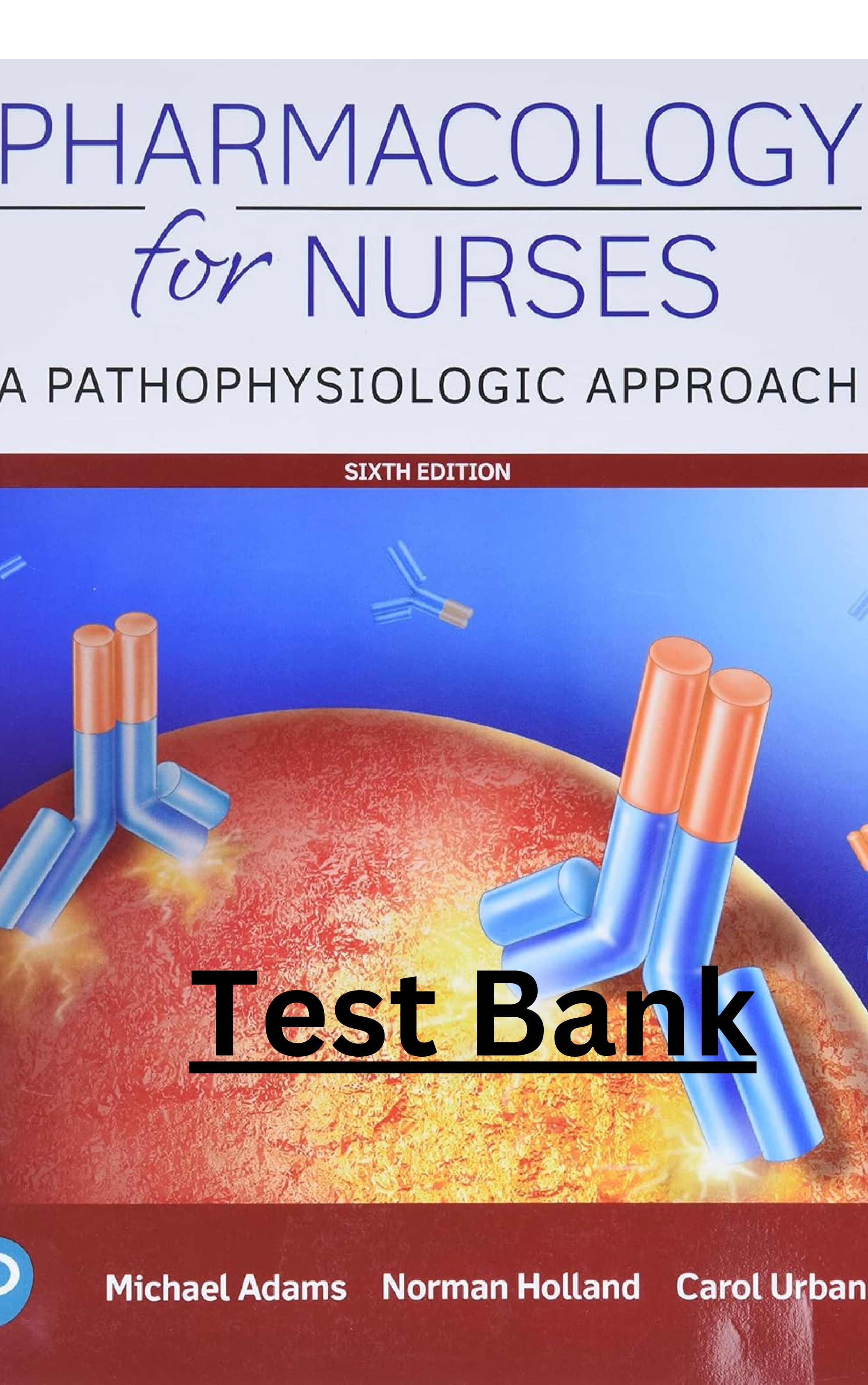
Reviews( 0 )
Document information
Connected school, study & course
About the document
Uploaded On
Mar 08, 2023
Number of pages
306
Written in
Additional information
This document has been written for:
Uploaded
Mar 08, 2023
Downloads
0
Views
87


